Project Management Principles for Feasibility Test of Software Platform
VerifiedAdded on 2023/06/07
|24
|5592
|58
AI Summary
This project report analyses the technical and financial success of launching a software platform for real-time financial analysis. It includes options analysis, scope description, constraints and dependencies, and project deliverables.
Contribute Materials
Your contribution can guide someone’s learning journey. Share your
documents today.
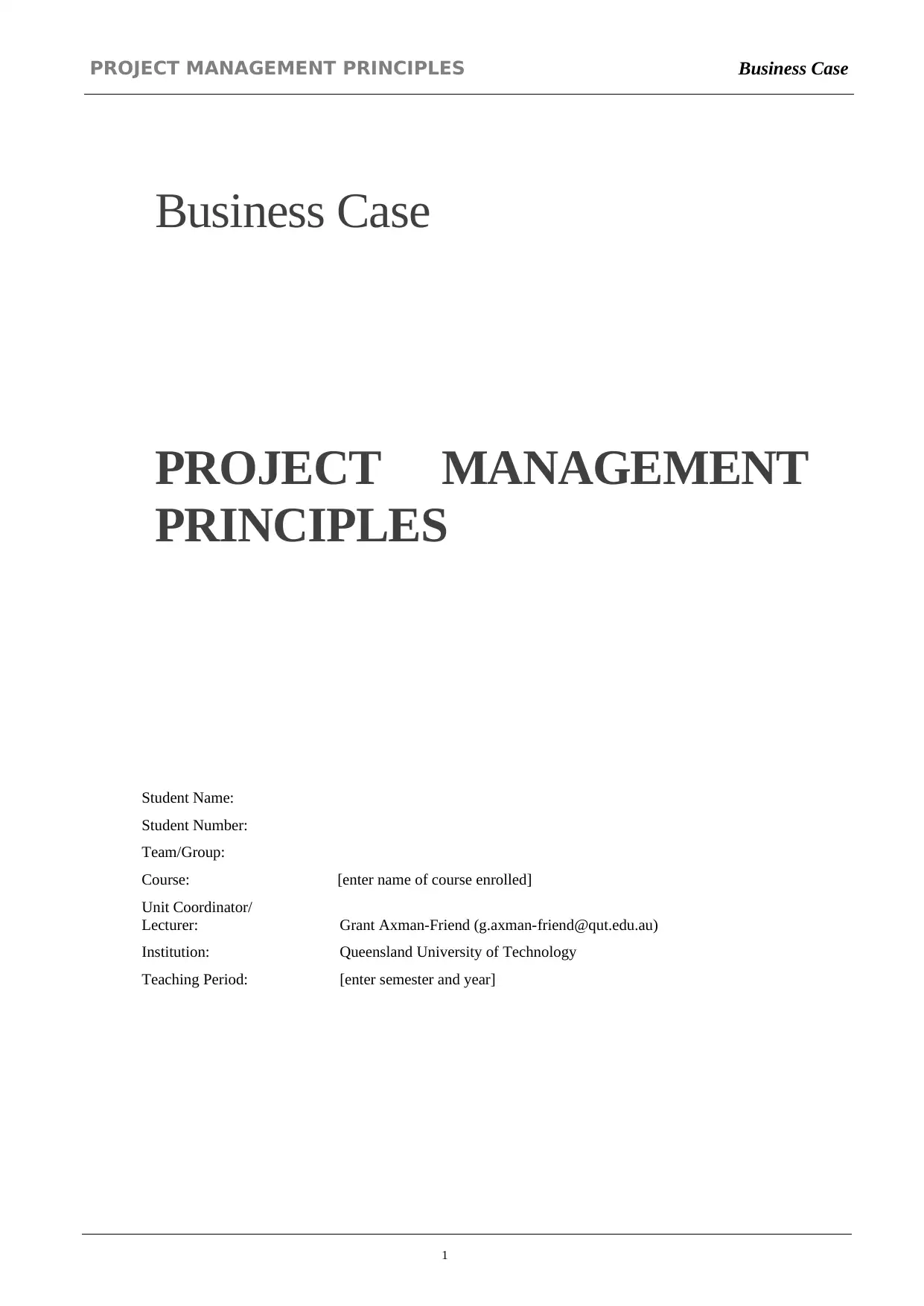
PROJECT MANAGEMENT PRINCIPLES Business Case
Business Case
PROJECT MANAGEMENT
PRINCIPLES
Student Name:
Student Number:
Team/Group:
Course: [enter name of course enrolled]
Unit Coordinator/
Lecturer: Grant Axman-Friend (g.axman-friend@qut.edu.au)
Institution: Queensland University of Technology
Teaching Period: [enter semester and year]
1
Business Case
PROJECT MANAGEMENT
PRINCIPLES
Student Name:
Student Number:
Team/Group:
Course: [enter name of course enrolled]
Unit Coordinator/
Lecturer: Grant Axman-Friend (g.axman-friend@qut.edu.au)
Institution: Queensland University of Technology
Teaching Period: [enter semester and year]
1
Secure Best Marks with AI Grader
Need help grading? Try our AI Grader for instant feedback on your assignments.
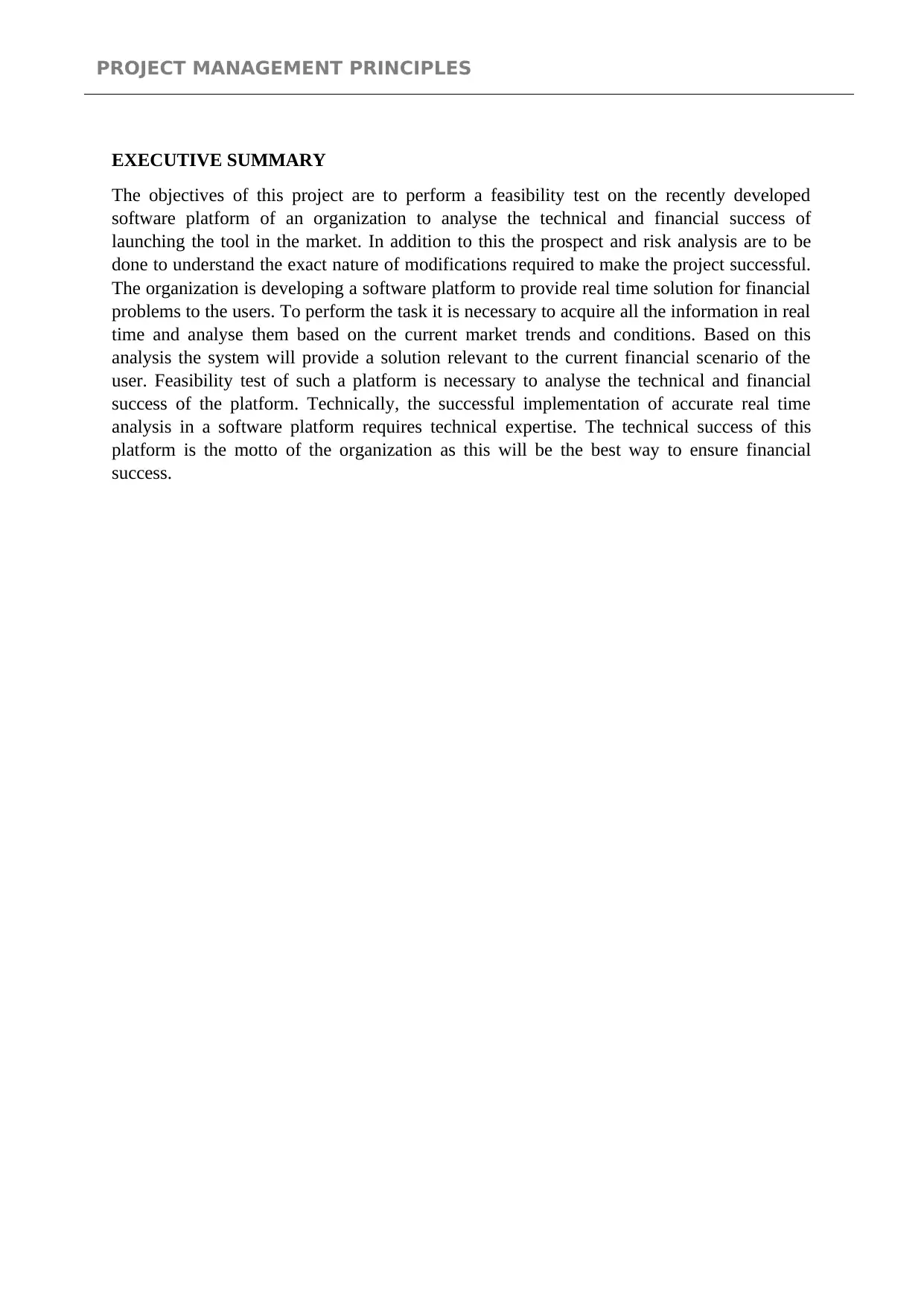
PROJECT MANAGEMENT PRINCIPLES
EXECUTIVE SUMMARY
The objectives of this project are to perform a feasibility test on the recently developed
software platform of an organization to analyse the technical and financial success of
launching the tool in the market. In addition to this the prospect and risk analysis are to be
done to understand the exact nature of modifications required to make the project successful.
The organization is developing a software platform to provide real time solution for financial
problems to the users. To perform the task it is necessary to acquire all the information in real
time and analyse them based on the current market trends and conditions. Based on this
analysis the system will provide a solution relevant to the current financial scenario of the
user. Feasibility test of such a platform is necessary to analyse the technical and financial
success of the platform. Technically, the successful implementation of accurate real time
analysis in a software platform requires technical expertise. The technical success of this
platform is the motto of the organization as this will be the best way to ensure financial
success.
EXECUTIVE SUMMARY
The objectives of this project are to perform a feasibility test on the recently developed
software platform of an organization to analyse the technical and financial success of
launching the tool in the market. In addition to this the prospect and risk analysis are to be
done to understand the exact nature of modifications required to make the project successful.
The organization is developing a software platform to provide real time solution for financial
problems to the users. To perform the task it is necessary to acquire all the information in real
time and analyse them based on the current market trends and conditions. Based on this
analysis the system will provide a solution relevant to the current financial scenario of the
user. Feasibility test of such a platform is necessary to analyse the technical and financial
success of the platform. Technically, the successful implementation of accurate real time
analysis in a software platform requires technical expertise. The technical success of this
platform is the motto of the organization as this will be the best way to ensure financial
success.
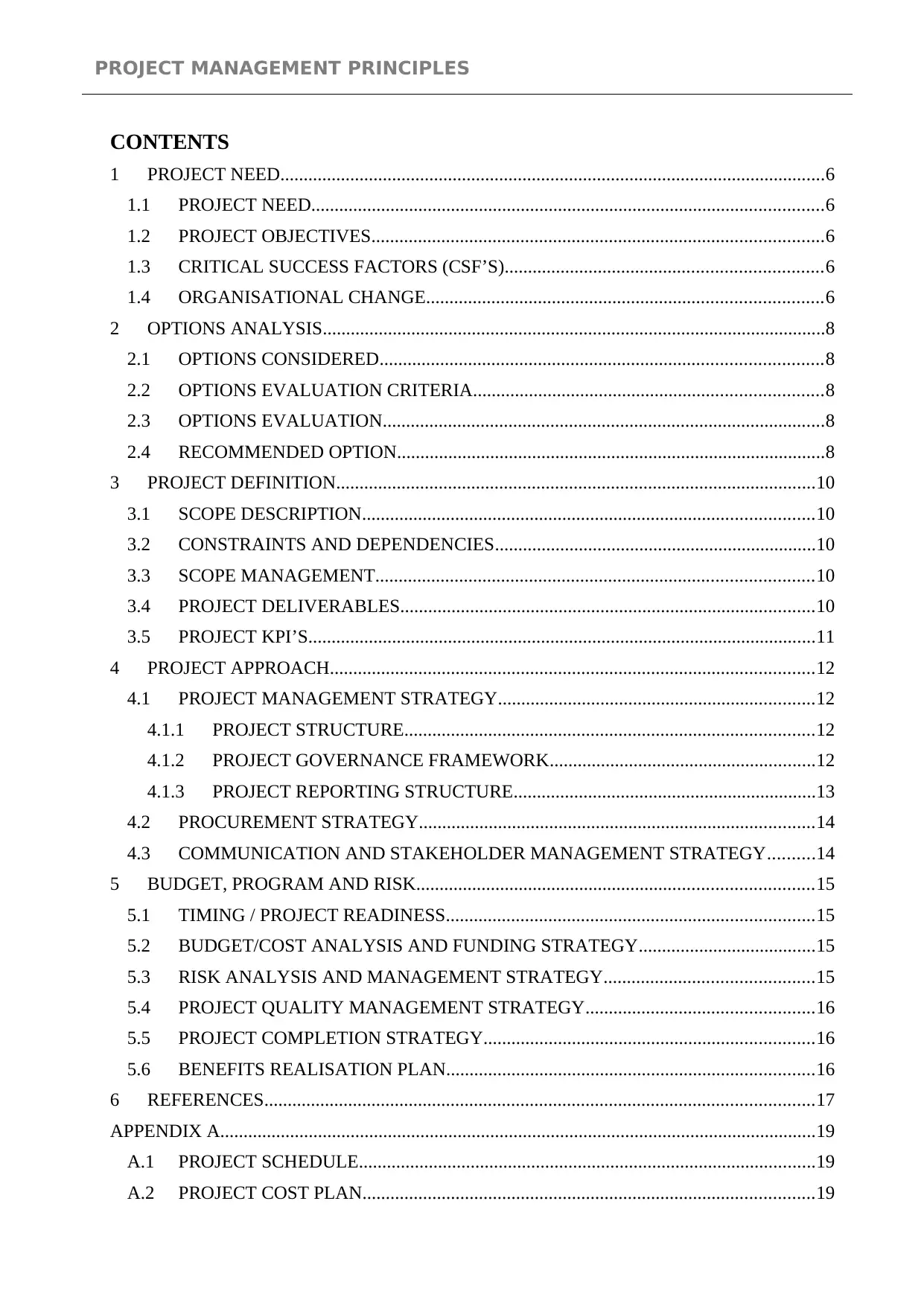
PROJECT MANAGEMENT PRINCIPLES
CONTENTS
1 PROJECT NEED.....................................................................................................................6
1.1 PROJECT NEED..............................................................................................................6
1.2 PROJECT OBJECTIVES.................................................................................................6
1.3 CRITICAL SUCCESS FACTORS (CSF’S)....................................................................6
1.4 ORGANISATIONAL CHANGE.....................................................................................6
2 OPTIONS ANALYSIS............................................................................................................8
2.1 OPTIONS CONSIDERED...............................................................................................8
2.2 OPTIONS EVALUATION CRITERIA...........................................................................8
2.3 OPTIONS EVALUATION...............................................................................................8
2.4 RECOMMENDED OPTION............................................................................................8
3 PROJECT DEFINITION.......................................................................................................10
3.1 SCOPE DESCRIPTION.................................................................................................10
3.2 CONSTRAINTS AND DEPENDENCIES.....................................................................10
3.3 SCOPE MANAGEMENT..............................................................................................10
3.4 PROJECT DELIVERABLES.........................................................................................10
3.5 PROJECT KPI’S.............................................................................................................11
4 PROJECT APPROACH........................................................................................................12
4.1 PROJECT MANAGEMENT STRATEGY....................................................................12
4.1.1 PROJECT STRUCTURE........................................................................................12
4.1.2 PROJECT GOVERNANCE FRAMEWORK.........................................................12
4.1.3 PROJECT REPORTING STRUCTURE.................................................................13
4.2 PROCUREMENT STRATEGY.....................................................................................14
4.3 COMMUNICATION AND STAKEHOLDER MANAGEMENT STRATEGY..........14
5 BUDGET, PROGRAM AND RISK.....................................................................................15
5.1 TIMING / PROJECT READINESS...............................................................................15
5.2 BUDGET/COST ANALYSIS AND FUNDING STRATEGY......................................15
5.3 RISK ANALYSIS AND MANAGEMENT STRATEGY.............................................15
5.4 PROJECT QUALITY MANAGEMENT STRATEGY.................................................16
5.5 PROJECT COMPLETION STRATEGY.......................................................................16
5.6 BENEFITS REALISATION PLAN...............................................................................16
6 REFERENCES......................................................................................................................17
APPENDIX A................................................................................................................................19
A.1 PROJECT SCHEDULE..................................................................................................19
A.2 PROJECT COST PLAN.................................................................................................19
CONTENTS
1 PROJECT NEED.....................................................................................................................6
1.1 PROJECT NEED..............................................................................................................6
1.2 PROJECT OBJECTIVES.................................................................................................6
1.3 CRITICAL SUCCESS FACTORS (CSF’S)....................................................................6
1.4 ORGANISATIONAL CHANGE.....................................................................................6
2 OPTIONS ANALYSIS............................................................................................................8
2.1 OPTIONS CONSIDERED...............................................................................................8
2.2 OPTIONS EVALUATION CRITERIA...........................................................................8
2.3 OPTIONS EVALUATION...............................................................................................8
2.4 RECOMMENDED OPTION............................................................................................8
3 PROJECT DEFINITION.......................................................................................................10
3.1 SCOPE DESCRIPTION.................................................................................................10
3.2 CONSTRAINTS AND DEPENDENCIES.....................................................................10
3.3 SCOPE MANAGEMENT..............................................................................................10
3.4 PROJECT DELIVERABLES.........................................................................................10
3.5 PROJECT KPI’S.............................................................................................................11
4 PROJECT APPROACH........................................................................................................12
4.1 PROJECT MANAGEMENT STRATEGY....................................................................12
4.1.1 PROJECT STRUCTURE........................................................................................12
4.1.2 PROJECT GOVERNANCE FRAMEWORK.........................................................12
4.1.3 PROJECT REPORTING STRUCTURE.................................................................13
4.2 PROCUREMENT STRATEGY.....................................................................................14
4.3 COMMUNICATION AND STAKEHOLDER MANAGEMENT STRATEGY..........14
5 BUDGET, PROGRAM AND RISK.....................................................................................15
5.1 TIMING / PROJECT READINESS...............................................................................15
5.2 BUDGET/COST ANALYSIS AND FUNDING STRATEGY......................................15
5.3 RISK ANALYSIS AND MANAGEMENT STRATEGY.............................................15
5.4 PROJECT QUALITY MANAGEMENT STRATEGY.................................................16
5.5 PROJECT COMPLETION STRATEGY.......................................................................16
5.6 BENEFITS REALISATION PLAN...............................................................................16
6 REFERENCES......................................................................................................................17
APPENDIX A................................................................................................................................19
A.1 PROJECT SCHEDULE..................................................................................................19
A.2 PROJECT COST PLAN.................................................................................................19

PROJECT MANAGEMENT PRINCIPLES Business Case
A.3 PROJECT RISK REGISTER.........................................................................................21
A.4 BENEFITS REALISATION PLAN...............................................................................21
A.5 STAKEHOLDER ASSESSMENT MATRIX................................................................22
4
A.3 PROJECT RISK REGISTER.........................................................................................21
A.4 BENEFITS REALISATION PLAN...............................................................................21
A.5 STAKEHOLDER ASSESSMENT MATRIX................................................................22
4
Secure Best Marks with AI Grader
Need help grading? Try our AI Grader for instant feedback on your assignments.

PROJECT MANAGEMENT PRINCIPLES Business Case
LIST OF TABLES
Table 2-1 | Project options...............................................................................................................7
Table 2-2 | Table 2 footer example – linked to contents.................................................................7
LIST OF FIGURES
No table of figures entries found.
5
LIST OF TABLES
Table 2-1 | Project options...............................................................................................................7
Table 2-2 | Table 2 footer example – linked to contents.................................................................7
LIST OF FIGURES
No table of figures entries found.
5
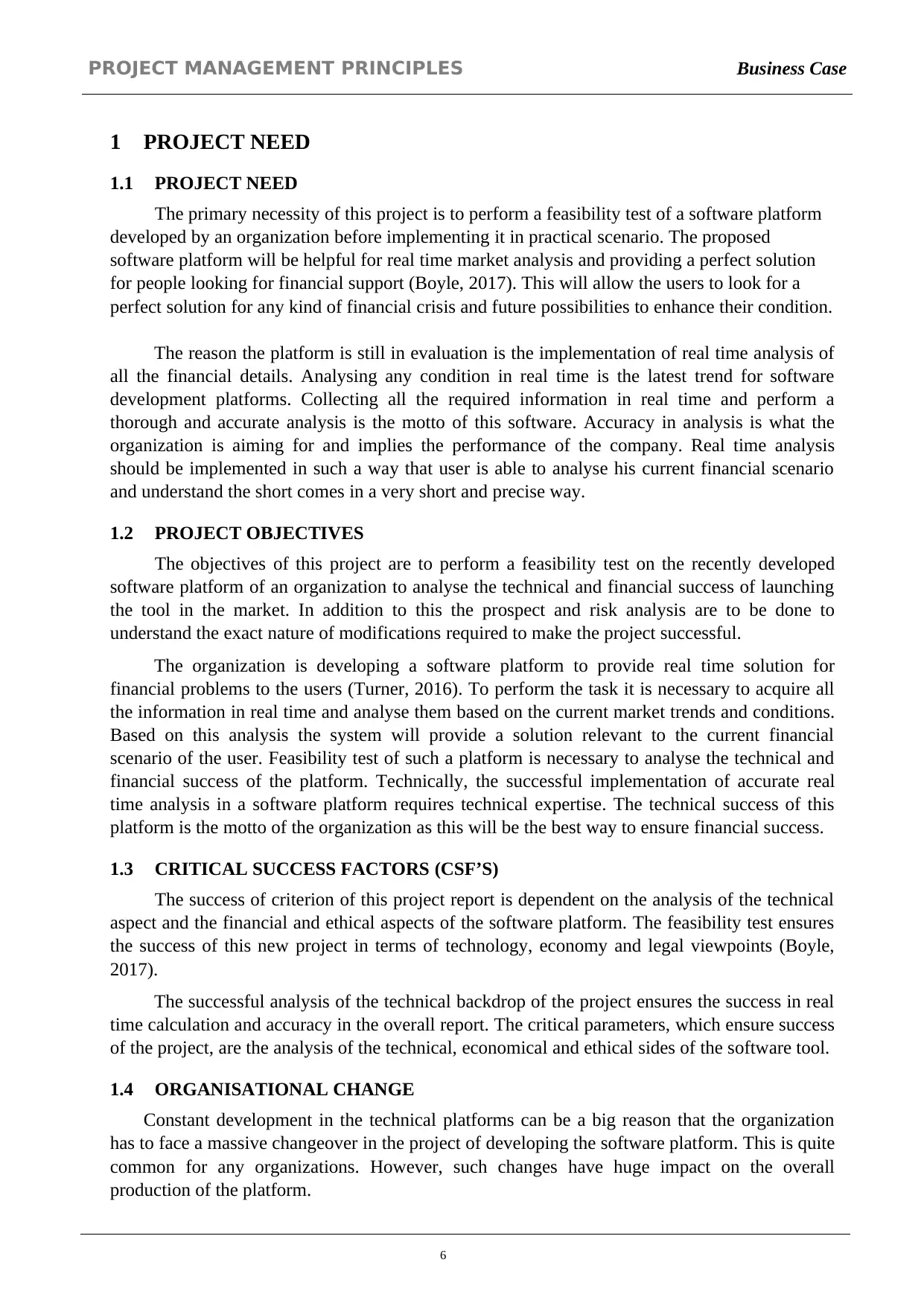
PROJECT MANAGEMENT PRINCIPLES Business Case
1 PROJECT NEED
1.1 PROJECT NEED
The primary necessity of this project is to perform a feasibility test of a software platform
developed by an organization before implementing it in practical scenario. The proposed
software platform will be helpful for real time market analysis and providing a perfect solution
for people looking for financial support (Boyle, 2017). This will allow the users to look for a
perfect solution for any kind of financial crisis and future possibilities to enhance their condition.
The reason the platform is still in evaluation is the implementation of real time analysis of
all the financial details. Analysing any condition in real time is the latest trend for software
development platforms. Collecting all the required information in real time and perform a
thorough and accurate analysis is the motto of this software. Accuracy in analysis is what the
organization is aiming for and implies the performance of the company. Real time analysis
should be implemented in such a way that user is able to analyse his current financial scenario
and understand the short comes in a very short and precise way.
1.2 PROJECT OBJECTIVES
The objectives of this project are to perform a feasibility test on the recently developed
software platform of an organization to analyse the technical and financial success of launching
the tool in the market. In addition to this the prospect and risk analysis are to be done to
understand the exact nature of modifications required to make the project successful.
The organization is developing a software platform to provide real time solution for
financial problems to the users (Turner, 2016). To perform the task it is necessary to acquire all
the information in real time and analyse them based on the current market trends and conditions.
Based on this analysis the system will provide a solution relevant to the current financial
scenario of the user. Feasibility test of such a platform is necessary to analyse the technical and
financial success of the platform. Technically, the successful implementation of accurate real
time analysis in a software platform requires technical expertise. The technical success of this
platform is the motto of the organization as this will be the best way to ensure financial success.
1.3 CRITICAL SUCCESS FACTORS (CSF’S)
The success of criterion of this project report is dependent on the analysis of the technical
aspect and the financial and ethical aspects of the software platform. The feasibility test ensures
the success of this new project in terms of technology, economy and legal viewpoints (Boyle,
2017).
The successful analysis of the technical backdrop of the project ensures the success in real
time calculation and accuracy in the overall report. The critical parameters, which ensure success
of the project, are the analysis of the technical, economical and ethical sides of the software tool.
1.4 ORGANISATIONAL CHANGE
Constant development in the technical platforms can be a big reason that the organization
has to face a massive changeover in the project of developing the software platform. This is quite
common for any organizations. However, such changes have huge impact on the overall
production of the platform.
6
1 PROJECT NEED
1.1 PROJECT NEED
The primary necessity of this project is to perform a feasibility test of a software platform
developed by an organization before implementing it in practical scenario. The proposed
software platform will be helpful for real time market analysis and providing a perfect solution
for people looking for financial support (Boyle, 2017). This will allow the users to look for a
perfect solution for any kind of financial crisis and future possibilities to enhance their condition.
The reason the platform is still in evaluation is the implementation of real time analysis of
all the financial details. Analysing any condition in real time is the latest trend for software
development platforms. Collecting all the required information in real time and perform a
thorough and accurate analysis is the motto of this software. Accuracy in analysis is what the
organization is aiming for and implies the performance of the company. Real time analysis
should be implemented in such a way that user is able to analyse his current financial scenario
and understand the short comes in a very short and precise way.
1.2 PROJECT OBJECTIVES
The objectives of this project are to perform a feasibility test on the recently developed
software platform of an organization to analyse the technical and financial success of launching
the tool in the market. In addition to this the prospect and risk analysis are to be done to
understand the exact nature of modifications required to make the project successful.
The organization is developing a software platform to provide real time solution for
financial problems to the users (Turner, 2016). To perform the task it is necessary to acquire all
the information in real time and analyse them based on the current market trends and conditions.
Based on this analysis the system will provide a solution relevant to the current financial
scenario of the user. Feasibility test of such a platform is necessary to analyse the technical and
financial success of the platform. Technically, the successful implementation of accurate real
time analysis in a software platform requires technical expertise. The technical success of this
platform is the motto of the organization as this will be the best way to ensure financial success.
1.3 CRITICAL SUCCESS FACTORS (CSF’S)
The success of criterion of this project report is dependent on the analysis of the technical
aspect and the financial and ethical aspects of the software platform. The feasibility test ensures
the success of this new project in terms of technology, economy and legal viewpoints (Boyle,
2017).
The successful analysis of the technical backdrop of the project ensures the success in real
time calculation and accuracy in the overall report. The critical parameters, which ensure success
of the project, are the analysis of the technical, economical and ethical sides of the software tool.
1.4 ORGANISATIONAL CHANGE
Constant development in the technical platforms can be a big reason that the organization
has to face a massive changeover in the project of developing the software platform. This is quite
common for any organizations. However, such changes have huge impact on the overall
production of the platform.
6

PROJECT MANAGEMENT PRINCIPLES Business Case
The major impacts of technology changeover will affect the production cost of the platform as a
whole and will affect the economic success of it. On the other hand, the technical success of the
software tool is also affected by this changeover (Kerzner & Kerzner, 2017). If newly launched
software is not supported by the latest technology then it can have a huge impact on the technical
aspects of the tool and in the end on the popularity of the tool. The popularity of any software
tool varies with the technical support of the platform. This is why the host organization has to go
through a huge changeover in case any massive technical changeover occurs in the market.
7
The major impacts of technology changeover will affect the production cost of the platform as a
whole and will affect the economic success of it. On the other hand, the technical success of the
software tool is also affected by this changeover (Kerzner & Kerzner, 2017). If newly launched
software is not supported by the latest technology then it can have a huge impact on the technical
aspects of the tool and in the end on the popularity of the tool. The popularity of any software
tool varies with the technical support of the platform. This is why the host organization has to go
through a huge changeover in case any massive technical changeover occurs in the market.
7
Paraphrase This Document
Need a fresh take? Get an instant paraphrase of this document with our AI Paraphraser
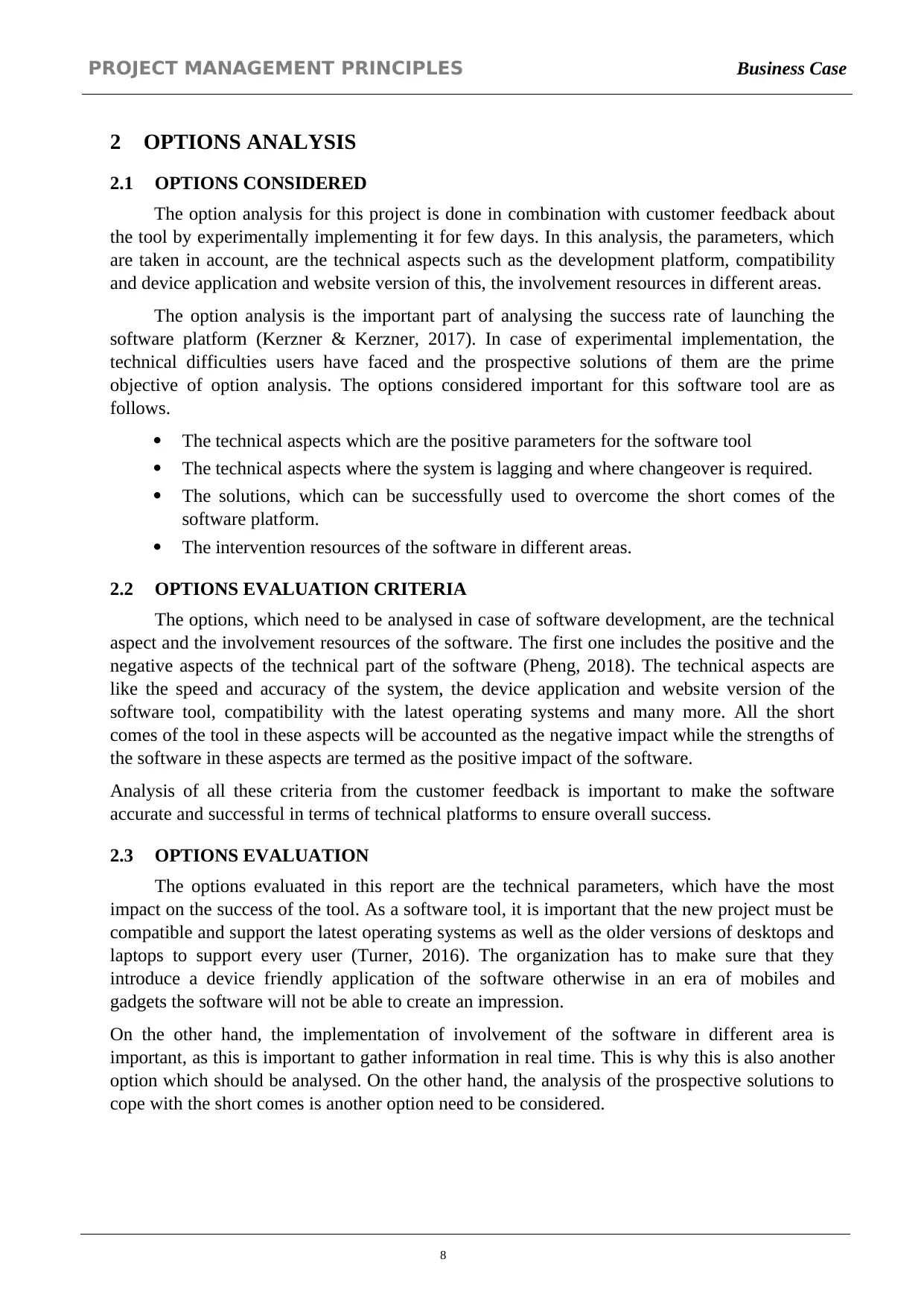
PROJECT MANAGEMENT PRINCIPLES Business Case
2 OPTIONS ANALYSIS
2.1 OPTIONS CONSIDERED
The option analysis for this project is done in combination with customer feedback about
the tool by experimentally implementing it for few days. In this analysis, the parameters, which
are taken in account, are the technical aspects such as the development platform, compatibility
and device application and website version of this, the involvement resources in different areas.
The option analysis is the important part of analysing the success rate of launching the
software platform (Kerzner & Kerzner, 2017). In case of experimental implementation, the
technical difficulties users have faced and the prospective solutions of them are the prime
objective of option analysis. The options considered important for this software tool are as
follows.
The technical aspects which are the positive parameters for the software tool
The technical aspects where the system is lagging and where changeover is required.
The solutions, which can be successfully used to overcome the short comes of the
software platform.
The intervention resources of the software in different areas.
2.2 OPTIONS EVALUATION CRITERIA
The options, which need to be analysed in case of software development, are the technical
aspect and the involvement resources of the software. The first one includes the positive and the
negative aspects of the technical part of the software (Pheng, 2018). The technical aspects are
like the speed and accuracy of the system, the device application and website version of the
software tool, compatibility with the latest operating systems and many more. All the short
comes of the tool in these aspects will be accounted as the negative impact while the strengths of
the software in these aspects are termed as the positive impact of the software.
Analysis of all these criteria from the customer feedback is important to make the software
accurate and successful in terms of technical platforms to ensure overall success.
2.3 OPTIONS EVALUATION
The options evaluated in this report are the technical parameters, which have the most
impact on the success of the tool. As a software tool, it is important that the new project must be
compatible and support the latest operating systems as well as the older versions of desktops and
laptops to support every user (Turner, 2016). The organization has to make sure that they
introduce a device friendly application of the software otherwise in an era of mobiles and
gadgets the software will not be able to create an impression.
On the other hand, the implementation of involvement of the software in different area is
important, as this is important to gather information in real time. This is why this is also another
option which should be analysed. On the other hand, the analysis of the prospective solutions to
cope with the short comes is another option need to be considered.
8
2 OPTIONS ANALYSIS
2.1 OPTIONS CONSIDERED
The option analysis for this project is done in combination with customer feedback about
the tool by experimentally implementing it for few days. In this analysis, the parameters, which
are taken in account, are the technical aspects such as the development platform, compatibility
and device application and website version of this, the involvement resources in different areas.
The option analysis is the important part of analysing the success rate of launching the
software platform (Kerzner & Kerzner, 2017). In case of experimental implementation, the
technical difficulties users have faced and the prospective solutions of them are the prime
objective of option analysis. The options considered important for this software tool are as
follows.
The technical aspects which are the positive parameters for the software tool
The technical aspects where the system is lagging and where changeover is required.
The solutions, which can be successfully used to overcome the short comes of the
software platform.
The intervention resources of the software in different areas.
2.2 OPTIONS EVALUATION CRITERIA
The options, which need to be analysed in case of software development, are the technical
aspect and the involvement resources of the software. The first one includes the positive and the
negative aspects of the technical part of the software (Pheng, 2018). The technical aspects are
like the speed and accuracy of the system, the device application and website version of the
software tool, compatibility with the latest operating systems and many more. All the short
comes of the tool in these aspects will be accounted as the negative impact while the strengths of
the software in these aspects are termed as the positive impact of the software.
Analysis of all these criteria from the customer feedback is important to make the software
accurate and successful in terms of technical platforms to ensure overall success.
2.3 OPTIONS EVALUATION
The options evaluated in this report are the technical parameters, which have the most
impact on the success of the tool. As a software tool, it is important that the new project must be
compatible and support the latest operating systems as well as the older versions of desktops and
laptops to support every user (Turner, 2016). The organization has to make sure that they
introduce a device friendly application of the software otherwise in an era of mobiles and
gadgets the software will not be able to create an impression.
On the other hand, the implementation of involvement of the software in different area is
important, as this is important to gather information in real time. This is why this is also another
option which should be analysed. On the other hand, the analysis of the prospective solutions to
cope with the short comes is another option need to be considered.
8
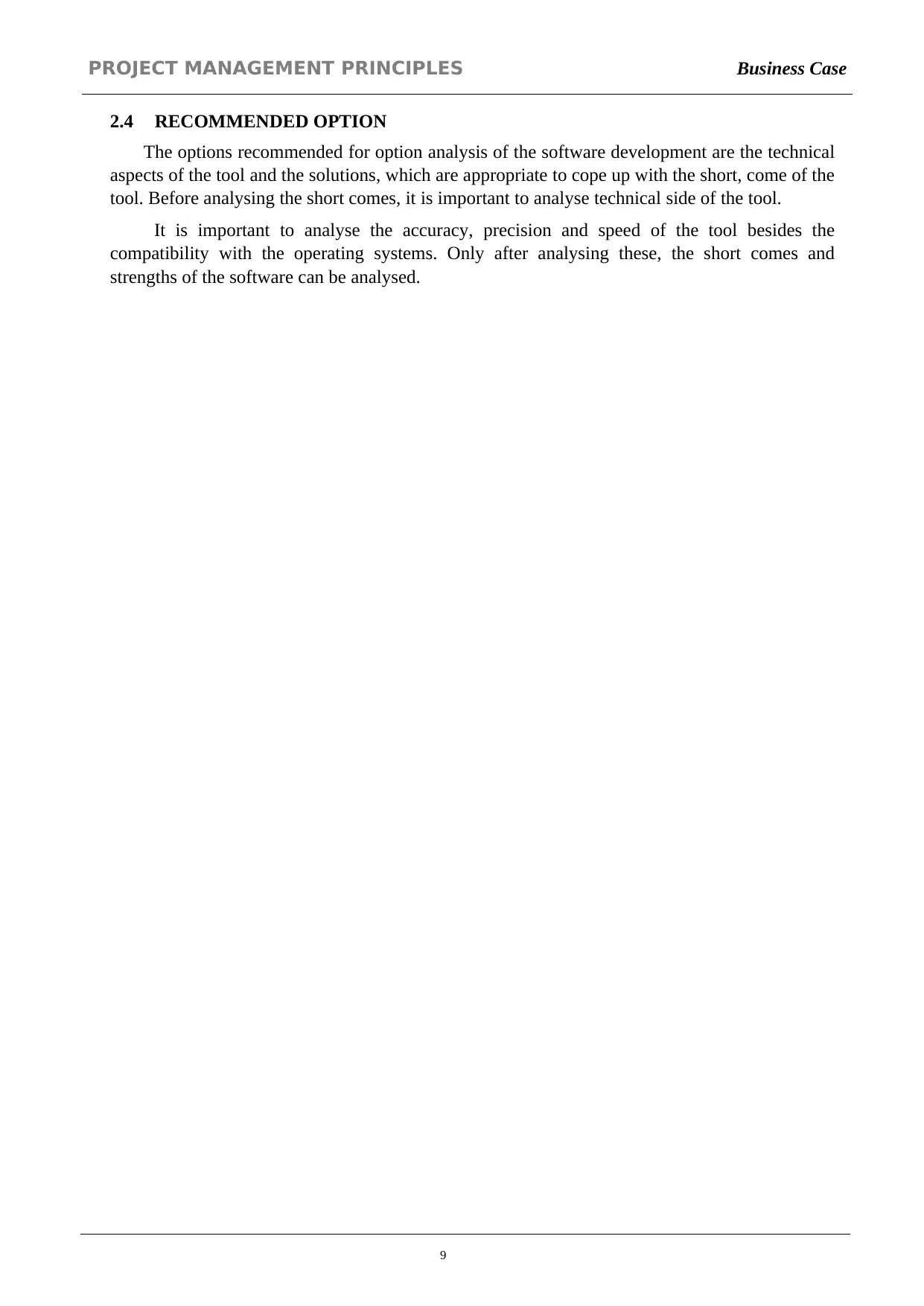
PROJECT MANAGEMENT PRINCIPLES Business Case
2.4 RECOMMENDED OPTION
The options recommended for option analysis of the software development are the technical
aspects of the tool and the solutions, which are appropriate to cope up with the short, come of the
tool. Before analysing the short comes, it is important to analyse technical side of the tool.
It is important to analyse the accuracy, precision and speed of the tool besides the
compatibility with the operating systems. Only after analysing these, the short comes and
strengths of the software can be analysed.
9
2.4 RECOMMENDED OPTION
The options recommended for option analysis of the software development are the technical
aspects of the tool and the solutions, which are appropriate to cope up with the short, come of the
tool. Before analysing the short comes, it is important to analyse technical side of the tool.
It is important to analyse the accuracy, precision and speed of the tool besides the
compatibility with the operating systems. Only after analysing these, the short comes and
strengths of the software can be analysed.
9
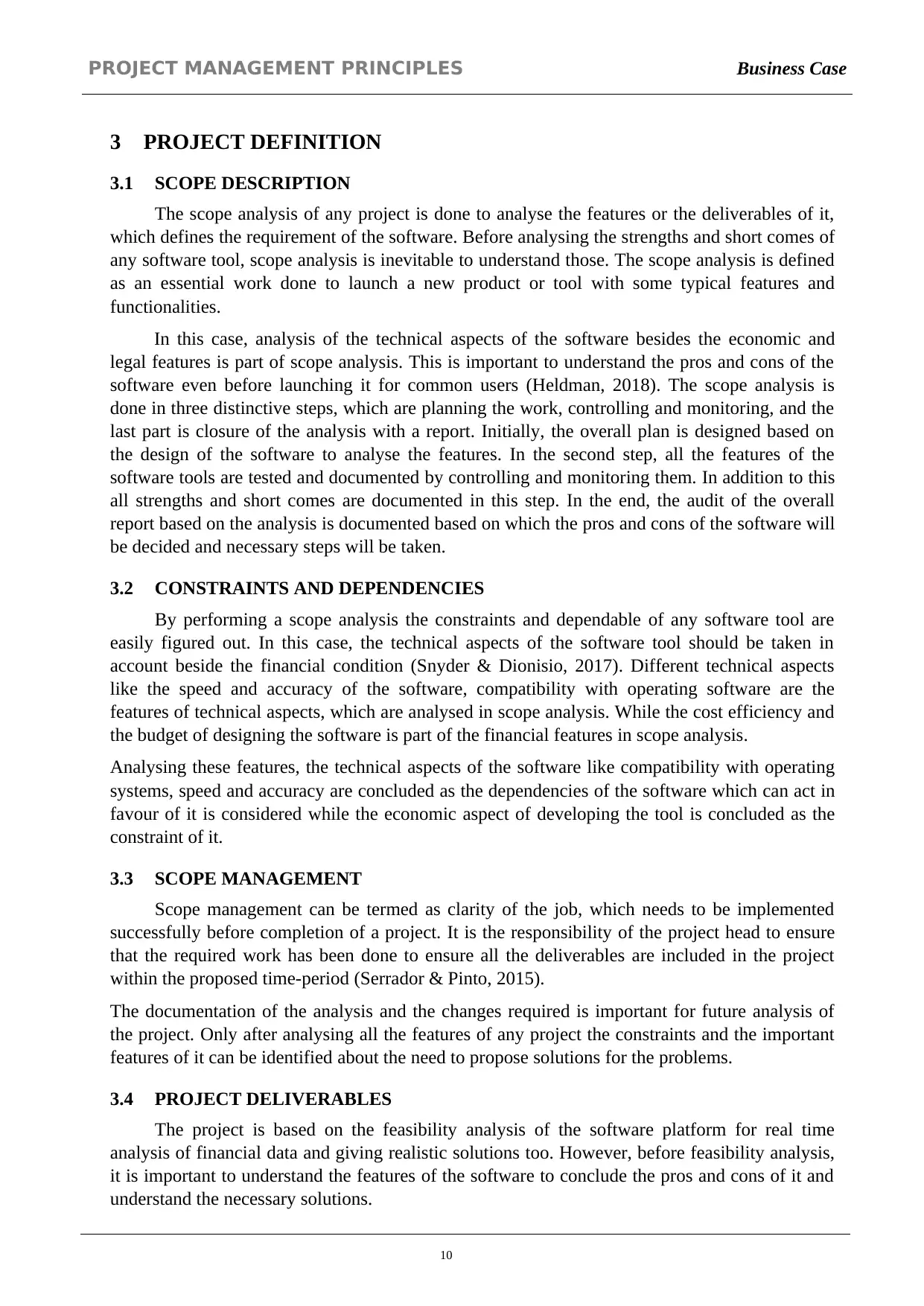
PROJECT MANAGEMENT PRINCIPLES Business Case
3 PROJECT DEFINITION
3.1 SCOPE DESCRIPTION
The scope analysis of any project is done to analyse the features or the deliverables of it,
which defines the requirement of the software. Before analysing the strengths and short comes of
any software tool, scope analysis is inevitable to understand those. The scope analysis is defined
as an essential work done to launch a new product or tool with some typical features and
functionalities.
In this case, analysis of the technical aspects of the software besides the economic and
legal features is part of scope analysis. This is important to understand the pros and cons of the
software even before launching it for common users (Heldman, 2018). The scope analysis is
done in three distinctive steps, which are planning the work, controlling and monitoring, and the
last part is closure of the analysis with a report. Initially, the overall plan is designed based on
the design of the software to analyse the features. In the second step, all the features of the
software tools are tested and documented by controlling and monitoring them. In addition to this
all strengths and short comes are documented in this step. In the end, the audit of the overall
report based on the analysis is documented based on which the pros and cons of the software will
be decided and necessary steps will be taken.
3.2 CONSTRAINTS AND DEPENDENCIES
By performing a scope analysis the constraints and dependable of any software tool are
easily figured out. In this case, the technical aspects of the software tool should be taken in
account beside the financial condition (Snyder & Dionisio, 2017). Different technical aspects
like the speed and accuracy of the software, compatibility with operating software are the
features of technical aspects, which are analysed in scope analysis. While the cost efficiency and
the budget of designing the software is part of the financial features in scope analysis.
Analysing these features, the technical aspects of the software like compatibility with operating
systems, speed and accuracy are concluded as the dependencies of the software which can act in
favour of it is considered while the economic aspect of developing the tool is concluded as the
constraint of it.
3.3 SCOPE MANAGEMENT
Scope management can be termed as clarity of the job, which needs to be implemented
successfully before completion of a project. It is the responsibility of the project head to ensure
that the required work has been done to ensure all the deliverables are included in the project
within the proposed time-period (Serrador & Pinto, 2015).
The documentation of the analysis and the changes required is important for future analysis of
the project. Only after analysing all the features of any project the constraints and the important
features of it can be identified about the need to propose solutions for the problems.
3.4 PROJECT DELIVERABLES
The project is based on the feasibility analysis of the software platform for real time
analysis of financial data and giving realistic solutions too. However, before feasibility analysis,
it is important to understand the features of the software to conclude the pros and cons of it and
understand the necessary solutions.
10
3 PROJECT DEFINITION
3.1 SCOPE DESCRIPTION
The scope analysis of any project is done to analyse the features or the deliverables of it,
which defines the requirement of the software. Before analysing the strengths and short comes of
any software tool, scope analysis is inevitable to understand those. The scope analysis is defined
as an essential work done to launch a new product or tool with some typical features and
functionalities.
In this case, analysis of the technical aspects of the software besides the economic and
legal features is part of scope analysis. This is important to understand the pros and cons of the
software even before launching it for common users (Heldman, 2018). The scope analysis is
done in three distinctive steps, which are planning the work, controlling and monitoring, and the
last part is closure of the analysis with a report. Initially, the overall plan is designed based on
the design of the software to analyse the features. In the second step, all the features of the
software tools are tested and documented by controlling and monitoring them. In addition to this
all strengths and short comes are documented in this step. In the end, the audit of the overall
report based on the analysis is documented based on which the pros and cons of the software will
be decided and necessary steps will be taken.
3.2 CONSTRAINTS AND DEPENDENCIES
By performing a scope analysis the constraints and dependable of any software tool are
easily figured out. In this case, the technical aspects of the software tool should be taken in
account beside the financial condition (Snyder & Dionisio, 2017). Different technical aspects
like the speed and accuracy of the software, compatibility with operating software are the
features of technical aspects, which are analysed in scope analysis. While the cost efficiency and
the budget of designing the software is part of the financial features in scope analysis.
Analysing these features, the technical aspects of the software like compatibility with operating
systems, speed and accuracy are concluded as the dependencies of the software which can act in
favour of it is considered while the economic aspect of developing the tool is concluded as the
constraint of it.
3.3 SCOPE MANAGEMENT
Scope management can be termed as clarity of the job, which needs to be implemented
successfully before completion of a project. It is the responsibility of the project head to ensure
that the required work has been done to ensure all the deliverables are included in the project
within the proposed time-period (Serrador & Pinto, 2015).
The documentation of the analysis and the changes required is important for future analysis of
the project. Only after analysing all the features of any project the constraints and the important
features of it can be identified about the need to propose solutions for the problems.
3.4 PROJECT DELIVERABLES
The project is based on the feasibility analysis of the software platform for real time
analysis of financial data and giving realistic solutions too. However, before feasibility analysis,
it is important to understand the features of the software to conclude the pros and cons of it and
understand the necessary solutions.
10
Secure Best Marks with AI Grader
Need help grading? Try our AI Grader for instant feedback on your assignments.
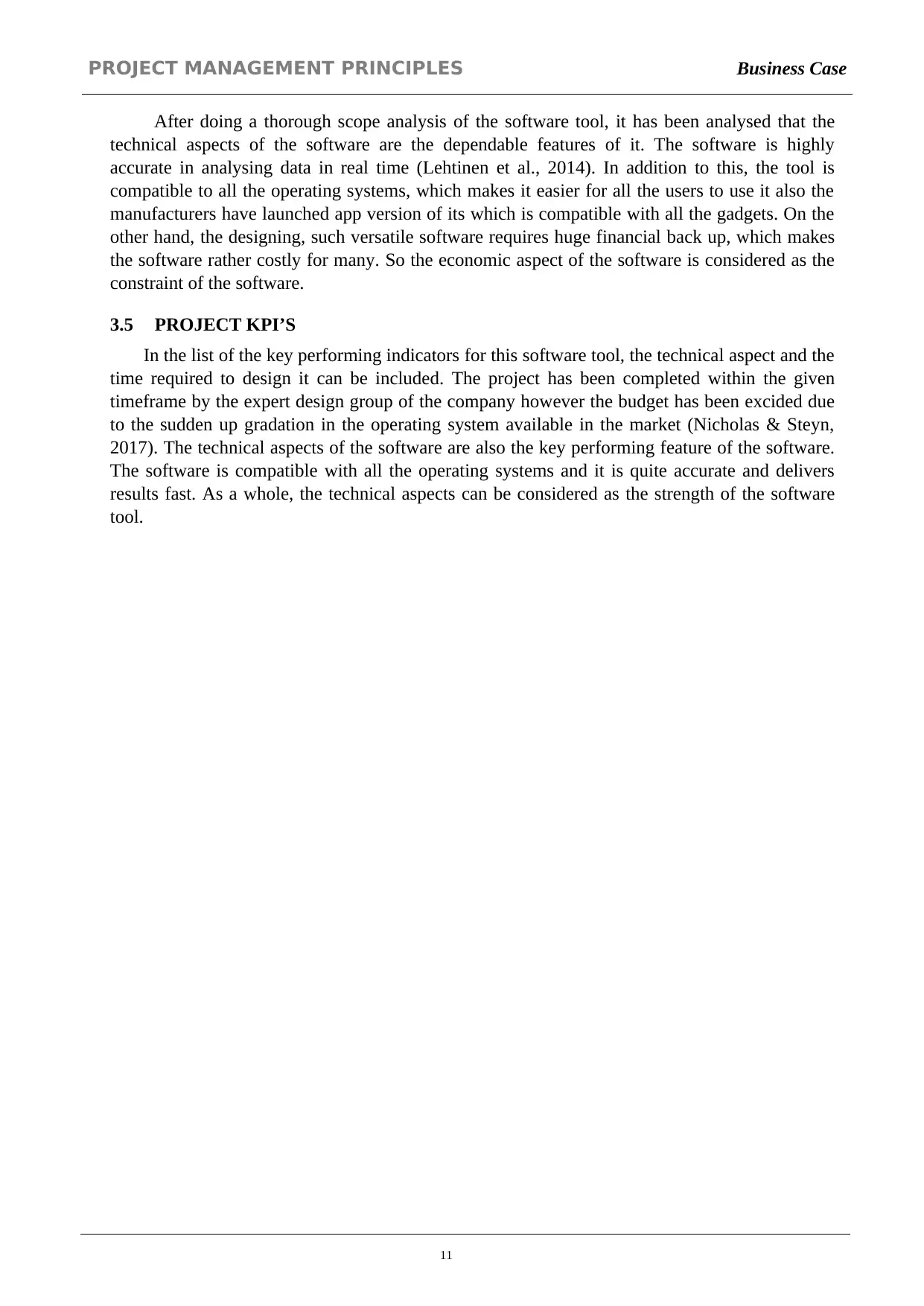
PROJECT MANAGEMENT PRINCIPLES Business Case
After doing a thorough scope analysis of the software tool, it has been analysed that the
technical aspects of the software are the dependable features of it. The software is highly
accurate in analysing data in real time (Lehtinen et al., 2014). In addition to this, the tool is
compatible to all the operating systems, which makes it easier for all the users to use it also the
manufacturers have launched app version of its which is compatible with all the gadgets. On the
other hand, the designing, such versatile software requires huge financial back up, which makes
the software rather costly for many. So the economic aspect of the software is considered as the
constraint of the software.
3.5 PROJECT KPI’S
In the list of the key performing indicators for this software tool, the technical aspect and the
time required to design it can be included. The project has been completed within the given
timeframe by the expert design group of the company however the budget has been excided due
to the sudden up gradation in the operating system available in the market (Nicholas & Steyn,
2017). The technical aspects of the software are also the key performing feature of the software.
The software is compatible with all the operating systems and it is quite accurate and delivers
results fast. As a whole, the technical aspects can be considered as the strength of the software
tool.
11
After doing a thorough scope analysis of the software tool, it has been analysed that the
technical aspects of the software are the dependable features of it. The software is highly
accurate in analysing data in real time (Lehtinen et al., 2014). In addition to this, the tool is
compatible to all the operating systems, which makes it easier for all the users to use it also the
manufacturers have launched app version of its which is compatible with all the gadgets. On the
other hand, the designing, such versatile software requires huge financial back up, which makes
the software rather costly for many. So the economic aspect of the software is considered as the
constraint of the software.
3.5 PROJECT KPI’S
In the list of the key performing indicators for this software tool, the technical aspect and the
time required to design it can be included. The project has been completed within the given
timeframe by the expert design group of the company however the budget has been excided due
to the sudden up gradation in the operating system available in the market (Nicholas & Steyn,
2017). The technical aspects of the software are also the key performing feature of the software.
The software is compatible with all the operating systems and it is quite accurate and delivers
results fast. As a whole, the technical aspects can be considered as the strength of the software
tool.
11
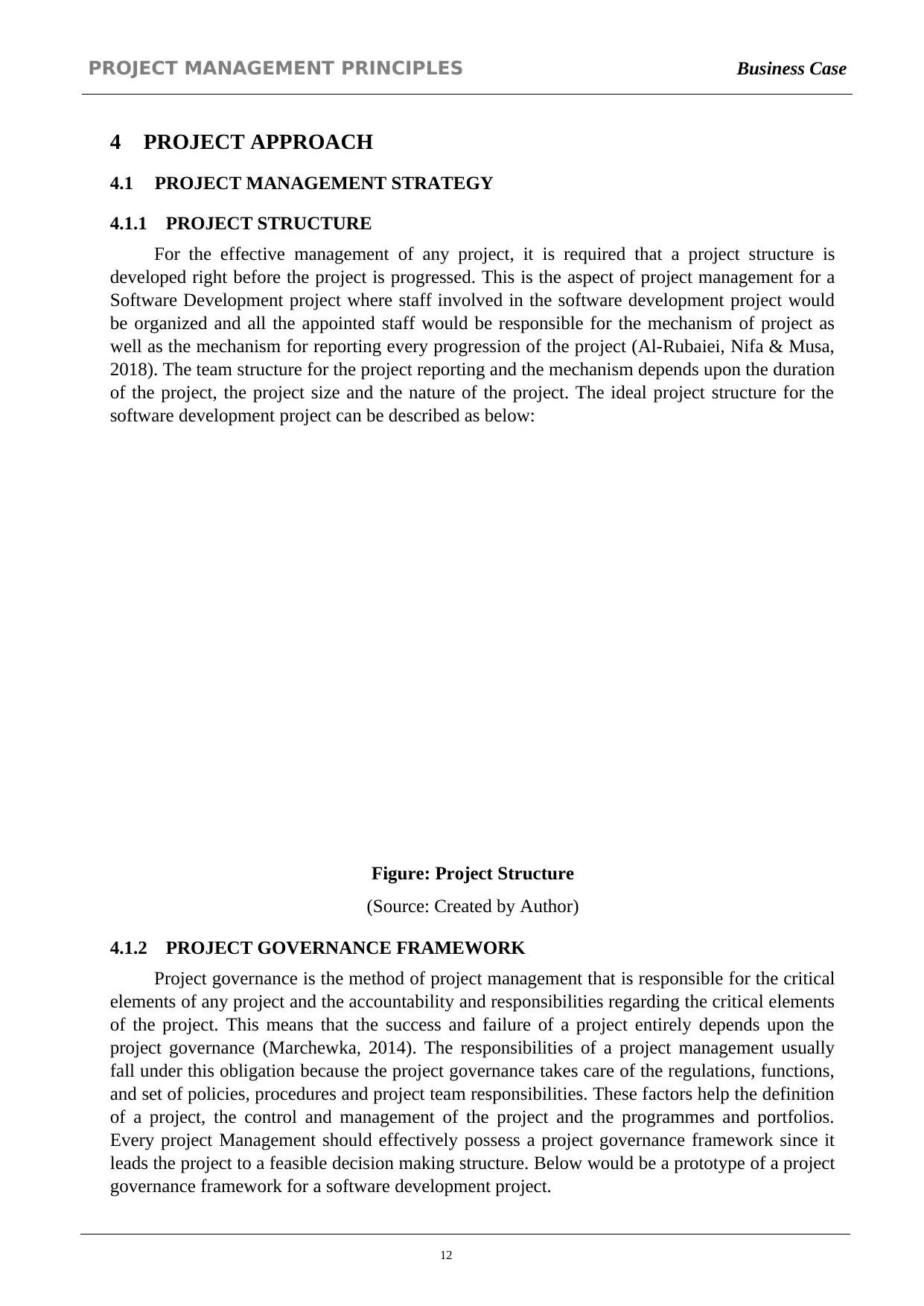
PROJECT MANAGEMENT PRINCIPLES Business Case
4 PROJECT APPROACH
4.1 PROJECT MANAGEMENT STRATEGY
4.1.1 PROJECT STRUCTURE
For the effective management of any project, it is required that a project structure is
developed right before the project is progressed. This is the aspect of project management for a
Software Development project where staff involved in the software development project would
be organized and all the appointed staff would be responsible for the mechanism of project as
well as the mechanism for reporting every progression of the project (Al-Rubaiei, Nifa & Musa,
2018). The team structure for the project reporting and the mechanism depends upon the duration
of the project, the project size and the nature of the project. The ideal project structure for the
software development project can be described as below:
Figure: Project Structure
(Source: Created by Author)
4.1.2 PROJECT GOVERNANCE FRAMEWORK
Project governance is the method of project management that is responsible for the critical
elements of any project and the accountability and responsibilities regarding the critical elements
of the project. This means that the success and failure of a project entirely depends upon the
project governance (Marchewka, 2014). The responsibilities of a project management usually
fall under this obligation because the project governance takes care of the regulations, functions,
and set of policies, procedures and project team responsibilities. These factors help the definition
of a project, the control and management of the project and the programmes and portfolios.
Every project Management should effectively possess a project governance framework since it
leads the project to a feasible decision making structure. Below would be a prototype of a project
governance framework for a software development project.
12
SoftwareDevelopmentProjectManagement
4 PROJECT APPROACH
4.1 PROJECT MANAGEMENT STRATEGY
4.1.1 PROJECT STRUCTURE
For the effective management of any project, it is required that a project structure is
developed right before the project is progressed. This is the aspect of project management for a
Software Development project where staff involved in the software development project would
be organized and all the appointed staff would be responsible for the mechanism of project as
well as the mechanism for reporting every progression of the project (Al-Rubaiei, Nifa & Musa,
2018). The team structure for the project reporting and the mechanism depends upon the duration
of the project, the project size and the nature of the project. The ideal project structure for the
software development project can be described as below:
Figure: Project Structure
(Source: Created by Author)
4.1.2 PROJECT GOVERNANCE FRAMEWORK
Project governance is the method of project management that is responsible for the critical
elements of any project and the accountability and responsibilities regarding the critical elements
of the project. This means that the success and failure of a project entirely depends upon the
project governance (Marchewka, 2014). The responsibilities of a project management usually
fall under this obligation because the project governance takes care of the regulations, functions,
and set of policies, procedures and project team responsibilities. These factors help the definition
of a project, the control and management of the project and the programmes and portfolios.
Every project Management should effectively possess a project governance framework since it
leads the project to a feasible decision making structure. Below would be a prototype of a project
governance framework for a software development project.
12
SoftwareDevelopmentProjectManagement
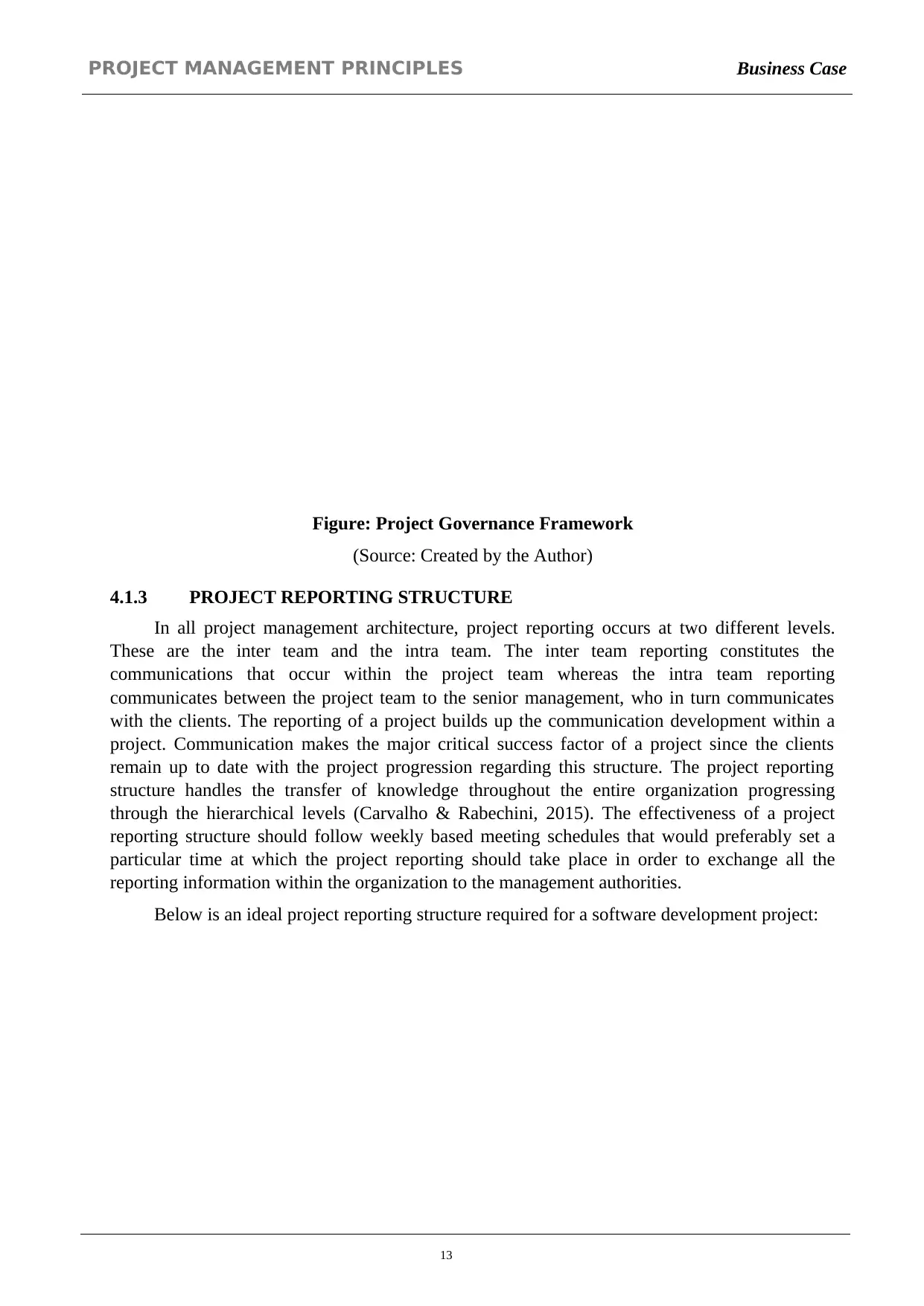
PROJECT MANAGEMENT PRINCIPLES Business Case
Figure: Project Governance Framework
(Source: Created by the Author)
4.1.3 PROJECT REPORTING STRUCTURE
In all project management architecture, project reporting occurs at two different levels.
These are the inter team and the intra team. The inter team reporting constitutes the
communications that occur within the project team whereas the intra team reporting
communicates between the project team to the senior management, who in turn communicates
with the clients. The reporting of a project builds up the communication development within a
project. Communication makes the major critical success factor of a project since the clients
remain up to date with the project progression regarding this structure. The project reporting
structure handles the transfer of knowledge throughout the entire organization progressing
through the hierarchical levels (Carvalho & Rabechini, 2015). The effectiveness of a project
reporting structure should follow weekly based meeting schedules that would preferably set a
particular time at which the project reporting should take place in order to exchange all the
reporting information within the organization to the management authorities.
Below is an ideal project reporting structure required for a software development project:
13
ProjectOwnerSeniorSupplierProjectDirectorProjectManagerProjectteamStrategicAdvisorsSeniorUser
Figure: Project Governance Framework
(Source: Created by the Author)
4.1.3 PROJECT REPORTING STRUCTURE
In all project management architecture, project reporting occurs at two different levels.
These are the inter team and the intra team. The inter team reporting constitutes the
communications that occur within the project team whereas the intra team reporting
communicates between the project team to the senior management, who in turn communicates
with the clients. The reporting of a project builds up the communication development within a
project. Communication makes the major critical success factor of a project since the clients
remain up to date with the project progression regarding this structure. The project reporting
structure handles the transfer of knowledge throughout the entire organization progressing
through the hierarchical levels (Carvalho & Rabechini, 2015). The effectiveness of a project
reporting structure should follow weekly based meeting schedules that would preferably set a
particular time at which the project reporting should take place in order to exchange all the
reporting information within the organization to the management authorities.
Below is an ideal project reporting structure required for a software development project:
13
ProjectOwnerSeniorSupplierProjectDirectorProjectManagerProjectteamStrategicAdvisorsSeniorUser
Paraphrase This Document
Need a fresh take? Get an instant paraphrase of this document with our AI Paraphraser
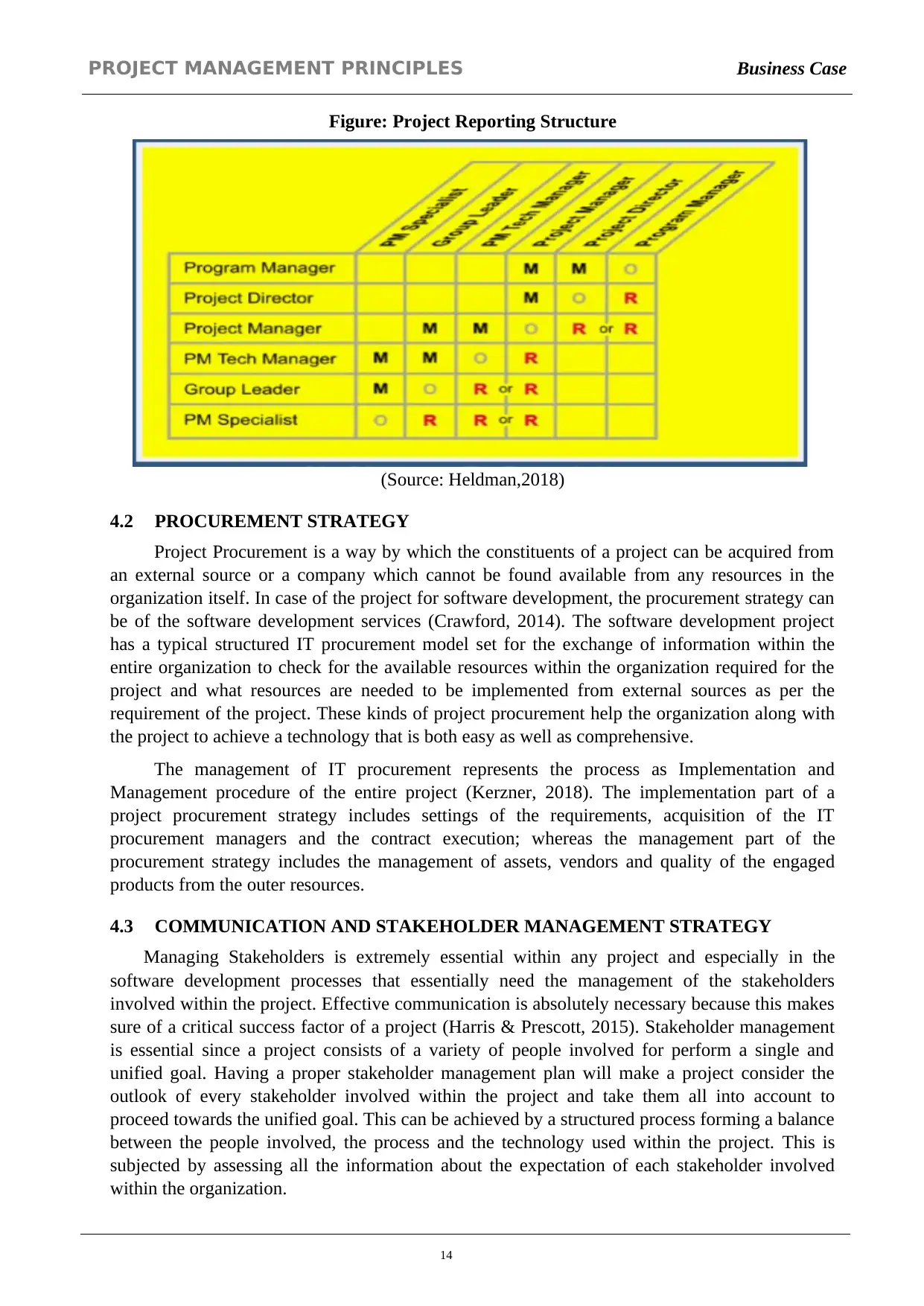
PROJECT MANAGEMENT PRINCIPLES Business Case
Figure: Project Reporting Structure
(Source: Heldman,2018)
4.2 PROCUREMENT STRATEGY
Project Procurement is a way by which the constituents of a project can be acquired from
an external source or a company which cannot be found available from any resources in the
organization itself. In case of the project for software development, the procurement strategy can
be of the software development services (Crawford, 2014). The software development project
has a typical structured IT procurement model set for the exchange of information within the
entire organization to check for the available resources within the organization required for the
project and what resources are needed to be implemented from external sources as per the
requirement of the project. These kinds of project procurement help the organization along with
the project to achieve a technology that is both easy as well as comprehensive.
The management of IT procurement represents the process as Implementation and
Management procedure of the entire project (Kerzner, 2018). The implementation part of a
project procurement strategy includes settings of the requirements, acquisition of the IT
procurement managers and the contract execution; whereas the management part of the
procurement strategy includes the management of assets, vendors and quality of the engaged
products from the outer resources.
4.3 COMMUNICATION AND STAKEHOLDER MANAGEMENT STRATEGY
Managing Stakeholders is extremely essential within any project and especially in the
software development processes that essentially need the management of the stakeholders
involved within the project. Effective communication is absolutely necessary because this makes
sure of a critical success factor of a project (Harris & Prescott, 2015). Stakeholder management
is essential since a project consists of a variety of people involved for perform a single and
unified goal. Having a proper stakeholder management plan will make a project consider the
outlook of every stakeholder involved within the project and take them all into account to
proceed towards the unified goal. This can be achieved by a structured process forming a balance
between the people involved, the process and the technology used within the project. This is
subjected by assessing all the information about the expectation of each stakeholder involved
within the organization.
14
Figure: Project Reporting Structure
(Source: Heldman,2018)
4.2 PROCUREMENT STRATEGY
Project Procurement is a way by which the constituents of a project can be acquired from
an external source or a company which cannot be found available from any resources in the
organization itself. In case of the project for software development, the procurement strategy can
be of the software development services (Crawford, 2014). The software development project
has a typical structured IT procurement model set for the exchange of information within the
entire organization to check for the available resources within the organization required for the
project and what resources are needed to be implemented from external sources as per the
requirement of the project. These kinds of project procurement help the organization along with
the project to achieve a technology that is both easy as well as comprehensive.
The management of IT procurement represents the process as Implementation and
Management procedure of the entire project (Kerzner, 2018). The implementation part of a
project procurement strategy includes settings of the requirements, acquisition of the IT
procurement managers and the contract execution; whereas the management part of the
procurement strategy includes the management of assets, vendors and quality of the engaged
products from the outer resources.
4.3 COMMUNICATION AND STAKEHOLDER MANAGEMENT STRATEGY
Managing Stakeholders is extremely essential within any project and especially in the
software development processes that essentially need the management of the stakeholders
involved within the project. Effective communication is absolutely necessary because this makes
sure of a critical success factor of a project (Harris & Prescott, 2015). Stakeholder management
is essential since a project consists of a variety of people involved for perform a single and
unified goal. Having a proper stakeholder management plan will make a project consider the
outlook of every stakeholder involved within the project and take them all into account to
proceed towards the unified goal. This can be achieved by a structured process forming a balance
between the people involved, the process and the technology used within the project. This is
subjected by assessing all the information about the expectation of each stakeholder involved
within the organization.
14
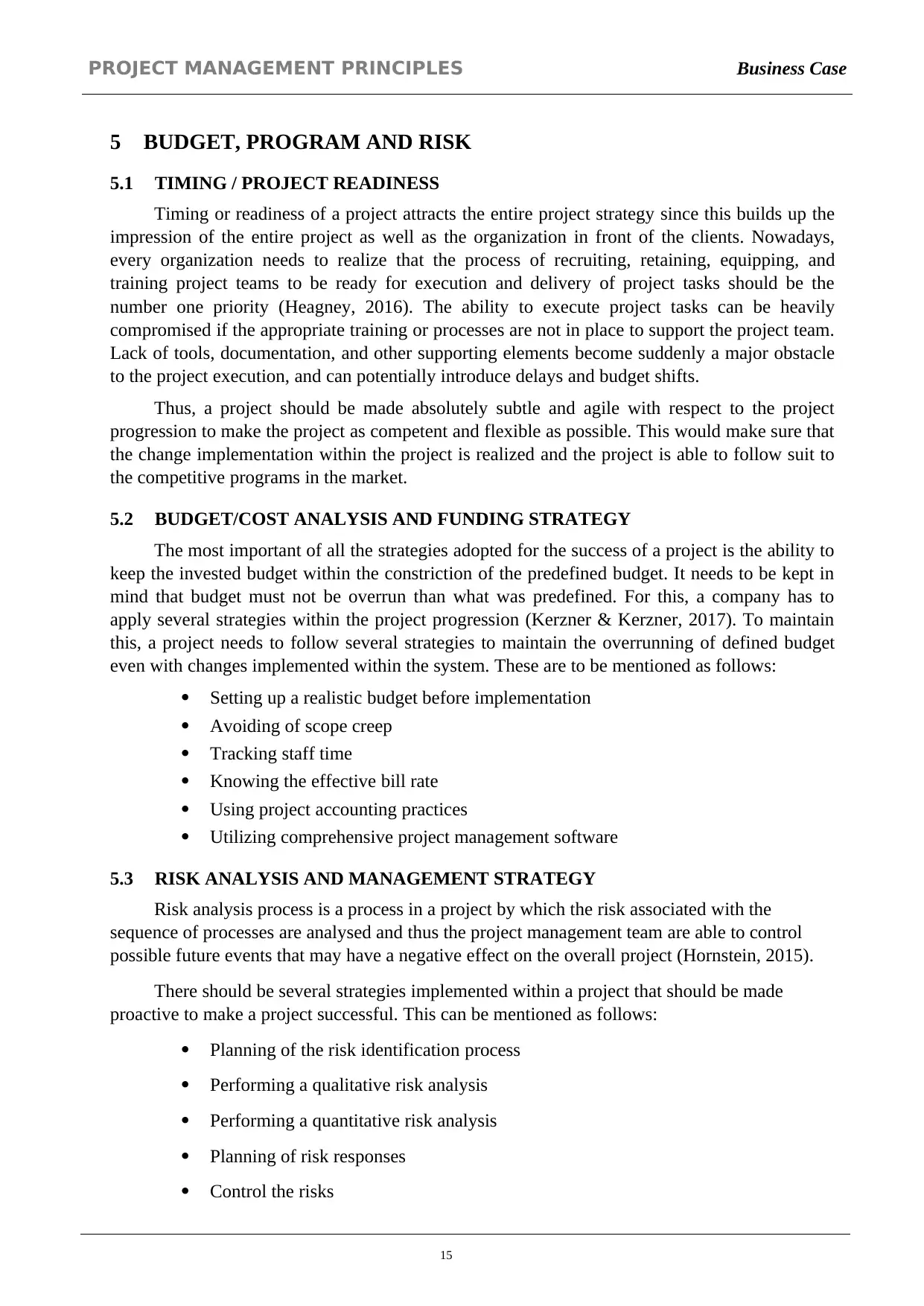
PROJECT MANAGEMENT PRINCIPLES Business Case
5 BUDGET, PROGRAM AND RISK
5.1 TIMING / PROJECT READINESS
Timing or readiness of a project attracts the entire project strategy since this builds up the
impression of the entire project as well as the organization in front of the clients. Nowadays,
every organization needs to realize that the process of recruiting, retaining, equipping, and
training project teams to be ready for execution and delivery of project tasks should be the
number one priority (Heagney, 2016). The ability to execute project tasks can be heavily
compromised if the appropriate training or processes are not in place to support the project team.
Lack of tools, documentation, and other supporting elements become suddenly a major obstacle
to the project execution, and can potentially introduce delays and budget shifts.
Thus, a project should be made absolutely subtle and agile with respect to the project
progression to make the project as competent and flexible as possible. This would make sure that
the change implementation within the project is realized and the project is able to follow suit to
the competitive programs in the market.
5.2 BUDGET/COST ANALYSIS AND FUNDING STRATEGY
The most important of all the strategies adopted for the success of a project is the ability to
keep the invested budget within the constriction of the predefined budget. It needs to be kept in
mind that budget must not be overrun than what was predefined. For this, a company has to
apply several strategies within the project progression (Kerzner & Kerzner, 2017). To maintain
this, a project needs to follow several strategies to maintain the overrunning of defined budget
even with changes implemented within the system. These are to be mentioned as follows:
Setting up a realistic budget before implementation
Avoiding of scope creep
Tracking staff time
Knowing the effective bill rate
Using project accounting practices
Utilizing comprehensive project management software
5.3 RISK ANALYSIS AND MANAGEMENT STRATEGY
Risk analysis process is a process in a project by which the risk associated with the
sequence of processes are analysed and thus the project management team are able to control
possible future events that may have a negative effect on the overall project (Hornstein, 2015).
There should be several strategies implemented within a project that should be made
proactive to make a project successful. This can be mentioned as follows:
Planning of the risk identification process
Performing a qualitative risk analysis
Performing a quantitative risk analysis
Planning of risk responses
Control the risks
15
5 BUDGET, PROGRAM AND RISK
5.1 TIMING / PROJECT READINESS
Timing or readiness of a project attracts the entire project strategy since this builds up the
impression of the entire project as well as the organization in front of the clients. Nowadays,
every organization needs to realize that the process of recruiting, retaining, equipping, and
training project teams to be ready for execution and delivery of project tasks should be the
number one priority (Heagney, 2016). The ability to execute project tasks can be heavily
compromised if the appropriate training or processes are not in place to support the project team.
Lack of tools, documentation, and other supporting elements become suddenly a major obstacle
to the project execution, and can potentially introduce delays and budget shifts.
Thus, a project should be made absolutely subtle and agile with respect to the project
progression to make the project as competent and flexible as possible. This would make sure that
the change implementation within the project is realized and the project is able to follow suit to
the competitive programs in the market.
5.2 BUDGET/COST ANALYSIS AND FUNDING STRATEGY
The most important of all the strategies adopted for the success of a project is the ability to
keep the invested budget within the constriction of the predefined budget. It needs to be kept in
mind that budget must not be overrun than what was predefined. For this, a company has to
apply several strategies within the project progression (Kerzner & Kerzner, 2017). To maintain
this, a project needs to follow several strategies to maintain the overrunning of defined budget
even with changes implemented within the system. These are to be mentioned as follows:
Setting up a realistic budget before implementation
Avoiding of scope creep
Tracking staff time
Knowing the effective bill rate
Using project accounting practices
Utilizing comprehensive project management software
5.3 RISK ANALYSIS AND MANAGEMENT STRATEGY
Risk analysis process is a process in a project by which the risk associated with the
sequence of processes are analysed and thus the project management team are able to control
possible future events that may have a negative effect on the overall project (Hornstein, 2015).
There should be several strategies implemented within a project that should be made
proactive to make a project successful. This can be mentioned as follows:
Planning of the risk identification process
Performing a qualitative risk analysis
Performing a quantitative risk analysis
Planning of risk responses
Control the risks
15
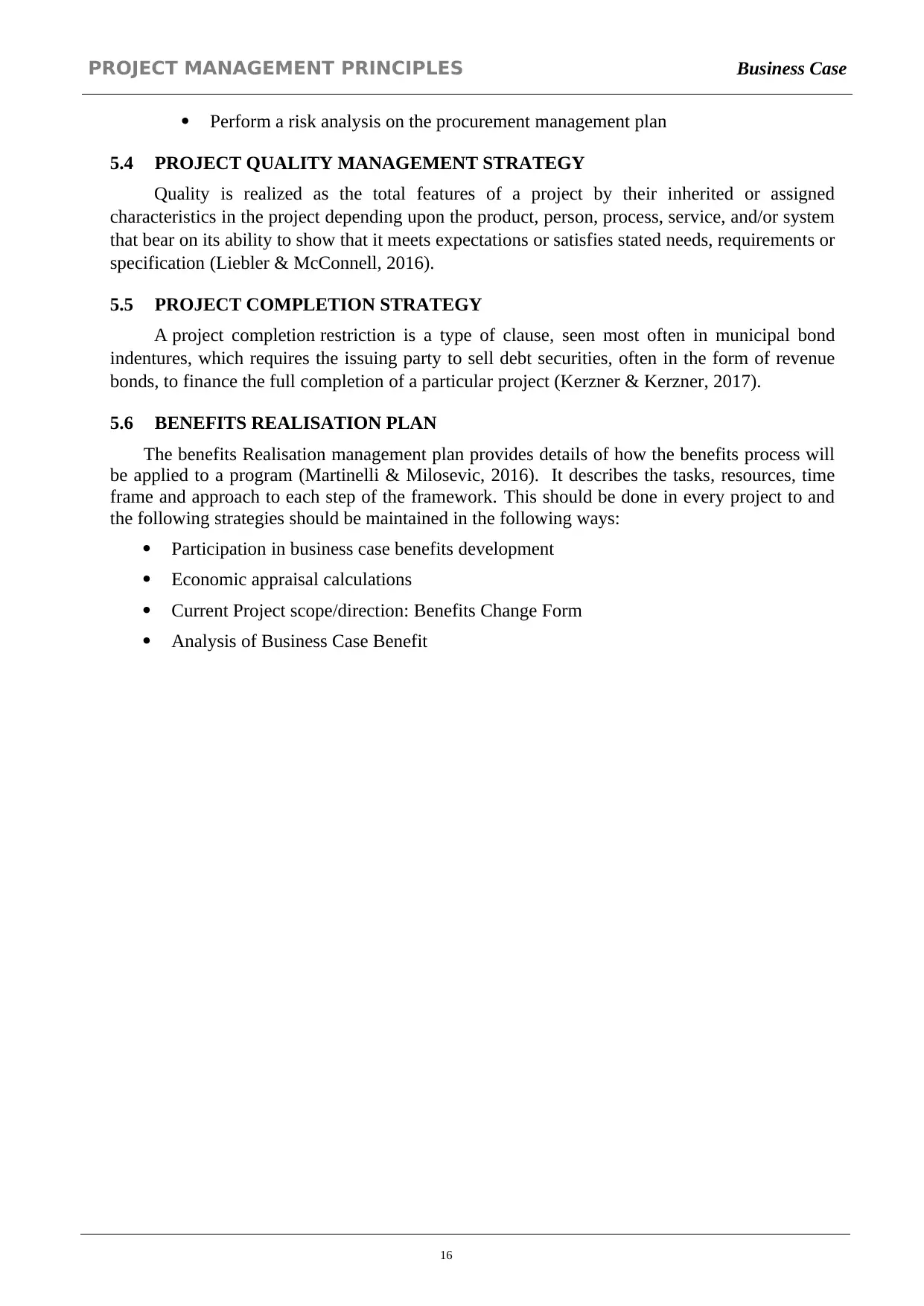
PROJECT MANAGEMENT PRINCIPLES Business Case
Perform a risk analysis on the procurement management plan
5.4 PROJECT QUALITY MANAGEMENT STRATEGY
Quality is realized as the total features of a project by their inherited or assigned
characteristics in the project depending upon the product, person, process, service, and/or system
that bear on its ability to show that it meets expectations or satisfies stated needs, requirements or
specification (Liebler & McConnell, 2016).
5.5 PROJECT COMPLETION STRATEGY
A project completion restriction is a type of clause, seen most often in municipal bond
indentures, which requires the issuing party to sell debt securities, often in the form of revenue
bonds, to finance the full completion of a particular project (Kerzner & Kerzner, 2017).
5.6 BENEFITS REALISATION PLAN
The benefits Realisation management plan provides details of how the benefits process will
be applied to a program (Martinelli & Milosevic, 2016). It describes the tasks, resources, time
frame and approach to each step of the framework. This should be done in every project to and
the following strategies should be maintained in the following ways:
Participation in business case benefits development
Economic appraisal calculations
Current Project scope/direction: Benefits Change Form
Analysis of Business Case Benefit
16
Perform a risk analysis on the procurement management plan
5.4 PROJECT QUALITY MANAGEMENT STRATEGY
Quality is realized as the total features of a project by their inherited or assigned
characteristics in the project depending upon the product, person, process, service, and/or system
that bear on its ability to show that it meets expectations or satisfies stated needs, requirements or
specification (Liebler & McConnell, 2016).
5.5 PROJECT COMPLETION STRATEGY
A project completion restriction is a type of clause, seen most often in municipal bond
indentures, which requires the issuing party to sell debt securities, often in the form of revenue
bonds, to finance the full completion of a particular project (Kerzner & Kerzner, 2017).
5.6 BENEFITS REALISATION PLAN
The benefits Realisation management plan provides details of how the benefits process will
be applied to a program (Martinelli & Milosevic, 2016). It describes the tasks, resources, time
frame and approach to each step of the framework. This should be done in every project to and
the following strategies should be maintained in the following ways:
Participation in business case benefits development
Economic appraisal calculations
Current Project scope/direction: Benefits Change Form
Analysis of Business Case Benefit
16
Secure Best Marks with AI Grader
Need help grading? Try our AI Grader for instant feedback on your assignments.
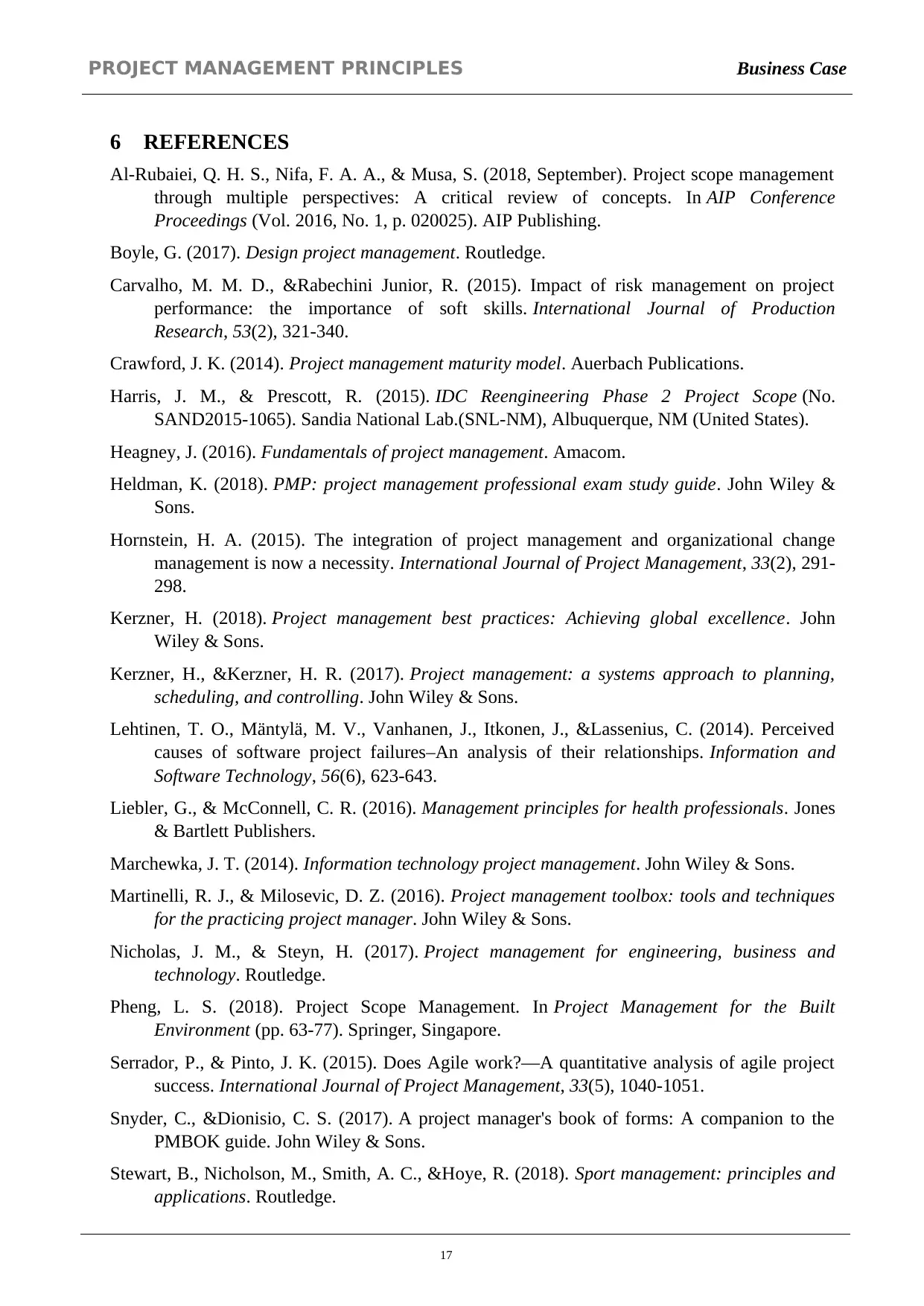
PROJECT MANAGEMENT PRINCIPLES Business Case
6 REFERENCES
Al-Rubaiei, Q. H. S., Nifa, F. A. A., & Musa, S. (2018, September). Project scope management
through multiple perspectives: A critical review of concepts. In AIP Conference
Proceedings (Vol. 2016, No. 1, p. 020025). AIP Publishing.
Boyle, G. (2017). Design project management. Routledge.
Carvalho, M. M. D., &Rabechini Junior, R. (2015). Impact of risk management on project
performance: the importance of soft skills. International Journal of Production
Research, 53(2), 321-340.
Crawford, J. K. (2014). Project management maturity model. Auerbach Publications.
Harris, J. M., & Prescott, R. (2015). IDC Reengineering Phase 2 Project Scope (No.
SAND2015-1065). Sandia National Lab.(SNL-NM), Albuquerque, NM (United States).
Heagney, J. (2016). Fundamentals of project management. Amacom.
Heldman, K. (2018). PMP: project management professional exam study guide. John Wiley &
Sons.
Hornstein, H. A. (2015). The integration of project management and organizational change
management is now a necessity. International Journal of Project Management, 33(2), 291-
298.
Kerzner, H. (2018). Project management best practices: Achieving global excellence. John
Wiley & Sons.
Kerzner, H., &Kerzner, H. R. (2017). Project management: a systems approach to planning,
scheduling, and controlling. John Wiley & Sons.
Lehtinen, T. O., Mäntylä, M. V., Vanhanen, J., Itkonen, J., &Lassenius, C. (2014). Perceived
causes of software project failures–An analysis of their relationships. Information and
Software Technology, 56(6), 623-643.
Liebler, G., & McConnell, C. R. (2016). Management principles for health professionals. Jones
& Bartlett Publishers.
Marchewka, J. T. (2014). Information technology project management. John Wiley & Sons.
Martinelli, R. J., & Milosevic, D. Z. (2016). Project management toolbox: tools and techniques
for the practicing project manager. John Wiley & Sons.
Nicholas, J. M., & Steyn, H. (2017). Project management for engineering, business and
technology. Routledge.
Pheng, L. S. (2018). Project Scope Management. In Project Management for the Built
Environment (pp. 63-77). Springer, Singapore.
Serrador, P., & Pinto, J. K. (2015). Does Agile work?—A quantitative analysis of agile project
success. International Journal of Project Management, 33(5), 1040-1051.
Snyder, C., &Dionisio, C. S. (2017). A project manager's book of forms: A companion to the
PMBOK guide. John Wiley & Sons.
Stewart, B., Nicholson, M., Smith, A. C., &Hoye, R. (2018). Sport management: principles and
applications. Routledge.
17
6 REFERENCES
Al-Rubaiei, Q. H. S., Nifa, F. A. A., & Musa, S. (2018, September). Project scope management
through multiple perspectives: A critical review of concepts. In AIP Conference
Proceedings (Vol. 2016, No. 1, p. 020025). AIP Publishing.
Boyle, G. (2017). Design project management. Routledge.
Carvalho, M. M. D., &Rabechini Junior, R. (2015). Impact of risk management on project
performance: the importance of soft skills. International Journal of Production
Research, 53(2), 321-340.
Crawford, J. K. (2014). Project management maturity model. Auerbach Publications.
Harris, J. M., & Prescott, R. (2015). IDC Reengineering Phase 2 Project Scope (No.
SAND2015-1065). Sandia National Lab.(SNL-NM), Albuquerque, NM (United States).
Heagney, J. (2016). Fundamentals of project management. Amacom.
Heldman, K. (2018). PMP: project management professional exam study guide. John Wiley &
Sons.
Hornstein, H. A. (2015). The integration of project management and organizational change
management is now a necessity. International Journal of Project Management, 33(2), 291-
298.
Kerzner, H. (2018). Project management best practices: Achieving global excellence. John
Wiley & Sons.
Kerzner, H., &Kerzner, H. R. (2017). Project management: a systems approach to planning,
scheduling, and controlling. John Wiley & Sons.
Lehtinen, T. O., Mäntylä, M. V., Vanhanen, J., Itkonen, J., &Lassenius, C. (2014). Perceived
causes of software project failures–An analysis of their relationships. Information and
Software Technology, 56(6), 623-643.
Liebler, G., & McConnell, C. R. (2016). Management principles for health professionals. Jones
& Bartlett Publishers.
Marchewka, J. T. (2014). Information technology project management. John Wiley & Sons.
Martinelli, R. J., & Milosevic, D. Z. (2016). Project management toolbox: tools and techniques
for the practicing project manager. John Wiley & Sons.
Nicholas, J. M., & Steyn, H. (2017). Project management for engineering, business and
technology. Routledge.
Pheng, L. S. (2018). Project Scope Management. In Project Management for the Built
Environment (pp. 63-77). Springer, Singapore.
Serrador, P., & Pinto, J. K. (2015). Does Agile work?—A quantitative analysis of agile project
success. International Journal of Project Management, 33(5), 1040-1051.
Snyder, C., &Dionisio, C. S. (2017). A project manager's book of forms: A companion to the
PMBOK guide. John Wiley & Sons.
Stewart, B., Nicholson, M., Smith, A. C., &Hoye, R. (2018). Sport management: principles and
applications. Routledge.
17
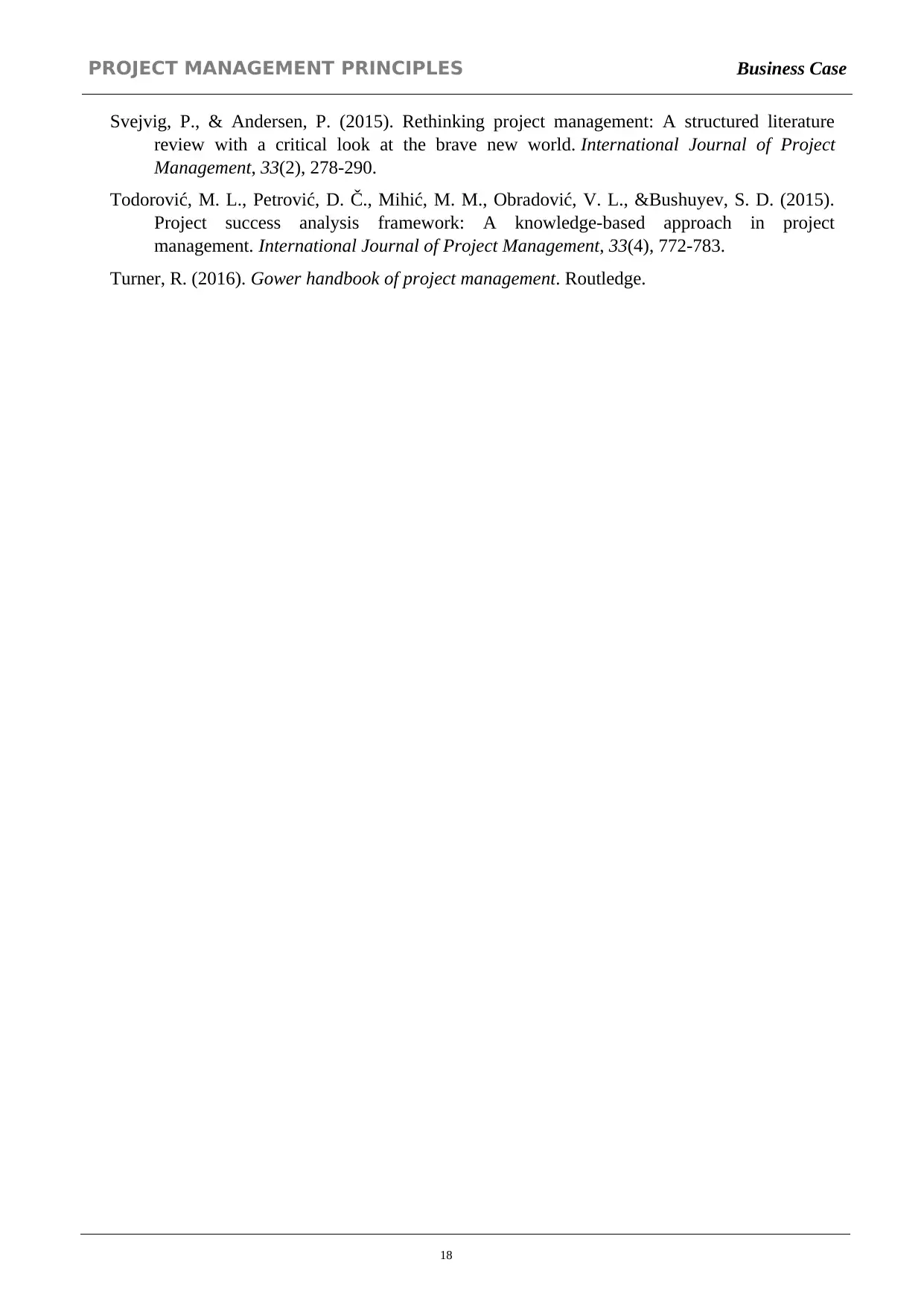
PROJECT MANAGEMENT PRINCIPLES Business Case
Svejvig, P., & Andersen, P. (2015). Rethinking project management: A structured literature
review with a critical look at the brave new world. International Journal of Project
Management, 33(2), 278-290.
Todorović, M. L., Petrović, D. Č., Mihić, M. M., Obradović, V. L., &Bushuyev, S. D. (2015).
Project success analysis framework: A knowledge-based approach in project
management. International Journal of Project Management, 33(4), 772-783.
Turner, R. (2016). Gower handbook of project management. Routledge.
18
Svejvig, P., & Andersen, P. (2015). Rethinking project management: A structured literature
review with a critical look at the brave new world. International Journal of Project
Management, 33(2), 278-290.
Todorović, M. L., Petrović, D. Č., Mihić, M. M., Obradović, V. L., &Bushuyev, S. D. (2015).
Project success analysis framework: A knowledge-based approach in project
management. International Journal of Project Management, 33(4), 772-783.
Turner, R. (2016). Gower handbook of project management. Routledge.
18
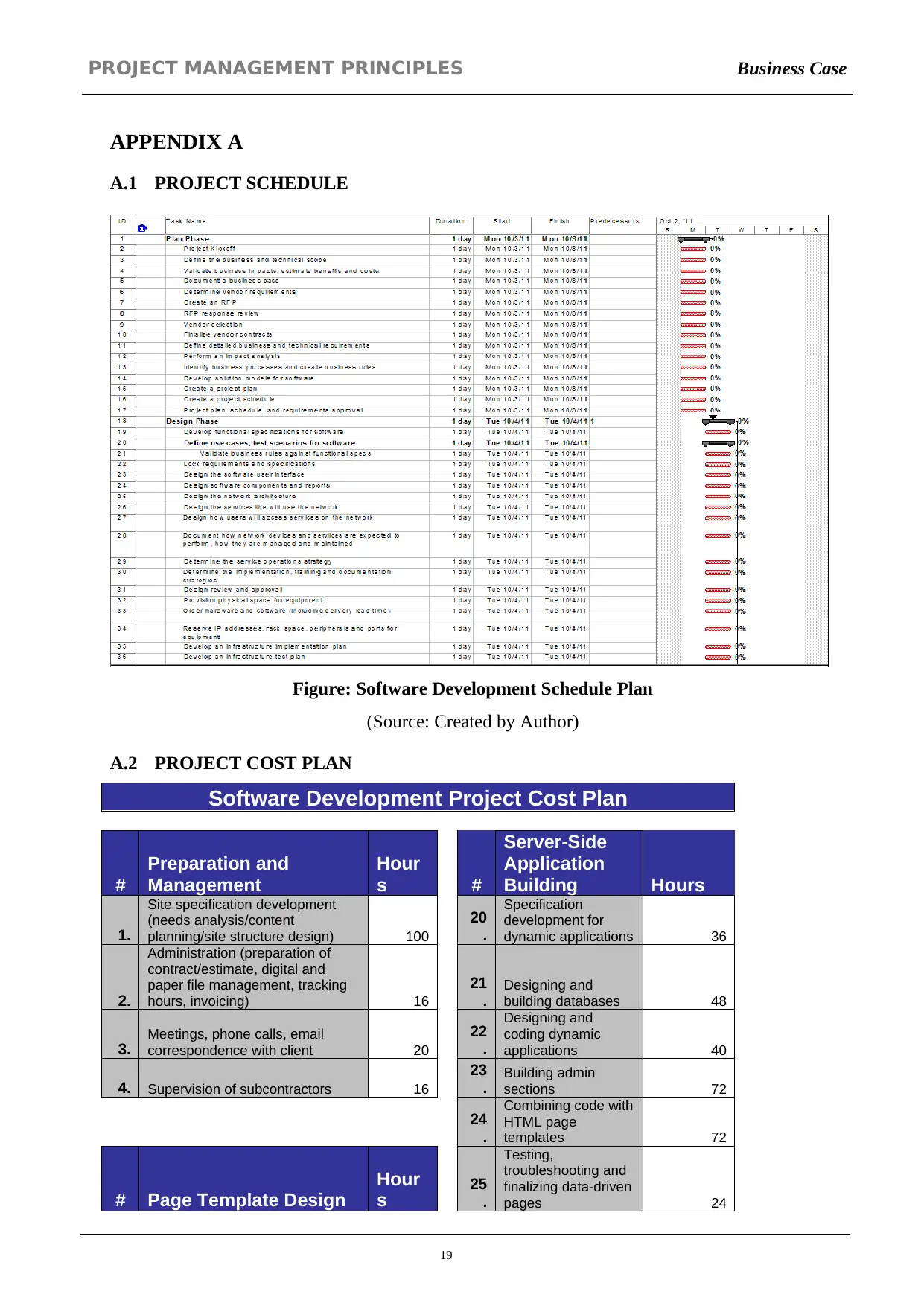
PROJECT MANAGEMENT PRINCIPLES Business Case
APPENDIX A
A.1 PROJECT SCHEDULE
Figure: Software Development Schedule Plan
(Source: Created by Author)
A.2 PROJECT COST PLAN
Software Development Project Cost Plan
#
Preparation and
Management
Hour
s #
Server-Side
Application
Building Hours
1.
Site specification development
(needs analysis/content
planning/site structure design) 100
20
.
Specification
development for
dynamic applications 36
2.
Administration (preparation of
contract/estimate, digital and
paper file management, tracking
hours, invoicing) 16
21
.
Designing and
building databases 48
3.
Meetings, phone calls, email
correspondence with client 20
22
.
Designing and
coding dynamic
applications 40
4. Supervision of subcontractors 16
23
.
Building admin
sections 72
24
.
Combining code with
HTML page
templates 72
# Page Template Design
Hour
s 25
.
Testing,
troubleshooting and
finalizing data-driven
pages 24
19
APPENDIX A
A.1 PROJECT SCHEDULE
Figure: Software Development Schedule Plan
(Source: Created by Author)
A.2 PROJECT COST PLAN
Software Development Project Cost Plan
#
Preparation and
Management
Hour
s #
Server-Side
Application
Building Hours
1.
Site specification development
(needs analysis/content
planning/site structure design) 100
20
.
Specification
development for
dynamic applications 36
2.
Administration (preparation of
contract/estimate, digital and
paper file management, tracking
hours, invoicing) 16
21
.
Designing and
building databases 48
3.
Meetings, phone calls, email
correspondence with client 20
22
.
Designing and
coding dynamic
applications 40
4. Supervision of subcontractors 16
23
.
Building admin
sections 72
24
.
Combining code with
HTML page
templates 72
# Page Template Design
Hour
s 25
.
Testing,
troubleshooting and
finalizing data-driven
pages 24
19
Paraphrase This Document
Need a fresh take? Get an instant paraphrase of this document with our AI Paraphraser
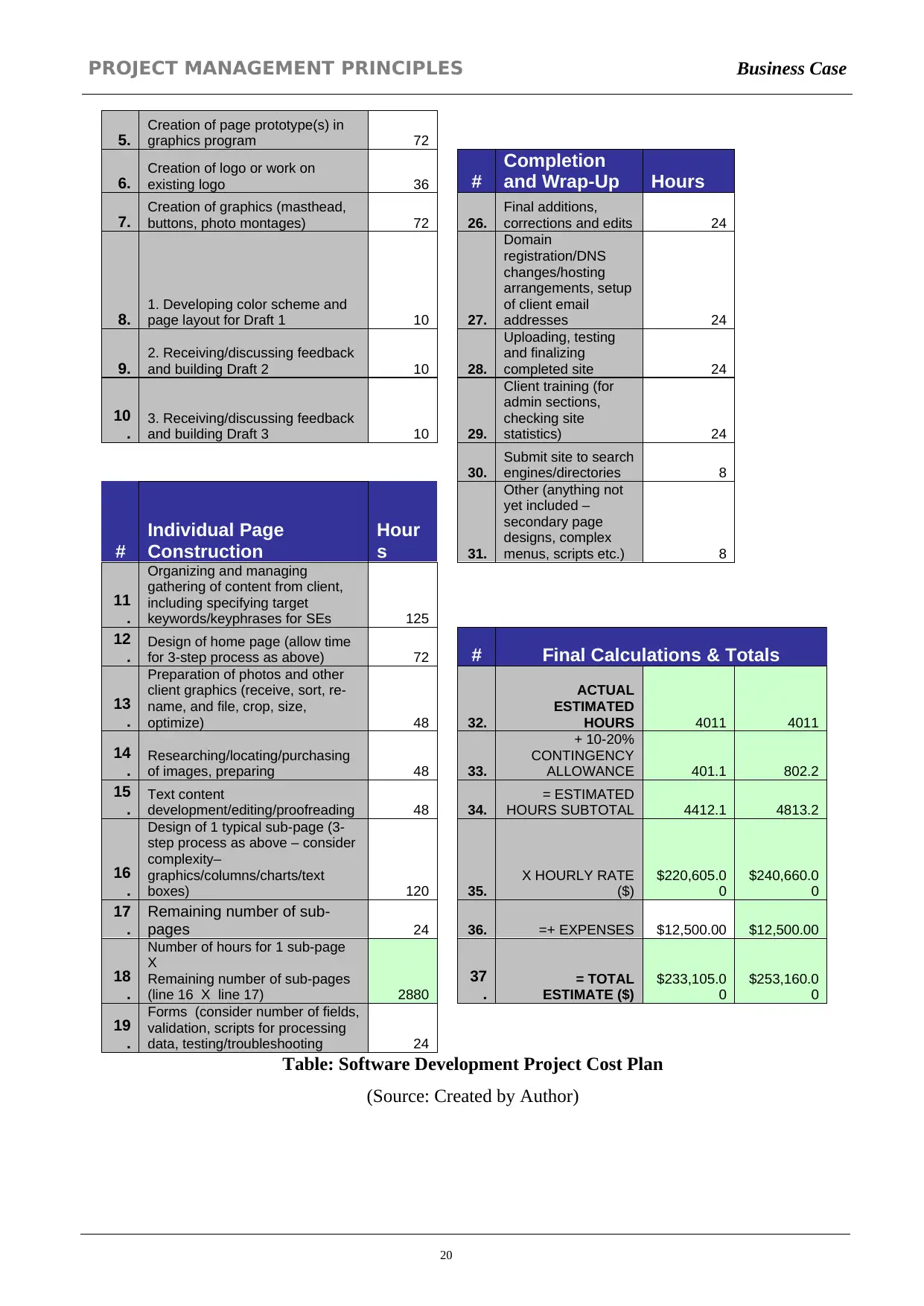
PROJECT MANAGEMENT PRINCIPLES Business Case
5.
Creation of page prototype(s) in
graphics program 72
6.
Creation of logo or work on
existing logo 36 #
Completion
and Wrap-Up Hours
7.
Creation of graphics (masthead,
buttons, photo montages) 72 26.
Final additions,
corrections and edits 24
8.
1. Developing color scheme and
page layout for Draft 1 10 27.
Domain
registration/DNS
changes/hosting
arrangements, setup
of client email
addresses 24
9.
2. Receiving/discussing feedback
and building Draft 2 10 28.
Uploading, testing
and finalizing
completed site 24
10
.
3. Receiving/discussing feedback
and building Draft 3 10 29.
Client training (for
admin sections,
checking site
statistics) 24
30.
Submit site to search
engines/directories 8
#
Individual Page
Construction
Hour
s 31.
Other (anything not
yet included –
secondary page
designs, complex
menus, scripts etc.) 8
11
.
Organizing and managing
gathering of content from client,
including specifying target
keywords/keyphrases for SEs 125
12
.
Design of home page (allow time
for 3-step process as above) 72 # Final Calculations & Totals
13
.
Preparation of photos and other
client graphics (receive, sort, re-
name, and file, crop, size,
optimize) 48 32.
ACTUAL
ESTIMATED
HOURS 4011 4011
14
.
Researching/locating/purchasing
of images, preparing 48 33.
+ 10-20%
CONTINGENCY
ALLOWANCE 401.1 802.2
15
.
Text content
development/editing/proofreading 48 34.
= ESTIMATED
HOURS SUBTOTAL 4412.1 4813.2
16
.
Design of 1 typical sub-page (3-
step process as above – consider
complexity–
graphics/columns/charts/text
boxes) 120 35.
X HOURLY RATE
($)
$220,605.0
0
$240,660.0
0
17
.
Remaining number of sub-
pages 24 36. =+ EXPENSES $12,500.00 $12,500.00
18
.
Number of hours for 1 sub-page
X
Remaining number of sub-pages
(line 16 X line 17) 2880
37
.
= TOTAL
ESTIMATE ($)
$233,105.0
0
$253,160.0
0
19
.
Forms (consider number of fields,
validation, scripts for processing
data, testing/troubleshooting 24
Table: Software Development Project Cost Plan
(Source: Created by Author)
20
5.
Creation of page prototype(s) in
graphics program 72
6.
Creation of logo or work on
existing logo 36 #
Completion
and Wrap-Up Hours
7.
Creation of graphics (masthead,
buttons, photo montages) 72 26.
Final additions,
corrections and edits 24
8.
1. Developing color scheme and
page layout for Draft 1 10 27.
Domain
registration/DNS
changes/hosting
arrangements, setup
of client email
addresses 24
9.
2. Receiving/discussing feedback
and building Draft 2 10 28.
Uploading, testing
and finalizing
completed site 24
10
.
3. Receiving/discussing feedback
and building Draft 3 10 29.
Client training (for
admin sections,
checking site
statistics) 24
30.
Submit site to search
engines/directories 8
#
Individual Page
Construction
Hour
s 31.
Other (anything not
yet included –
secondary page
designs, complex
menus, scripts etc.) 8
11
.
Organizing and managing
gathering of content from client,
including specifying target
keywords/keyphrases for SEs 125
12
.
Design of home page (allow time
for 3-step process as above) 72 # Final Calculations & Totals
13
.
Preparation of photos and other
client graphics (receive, sort, re-
name, and file, crop, size,
optimize) 48 32.
ACTUAL
ESTIMATED
HOURS 4011 4011
14
.
Researching/locating/purchasing
of images, preparing 48 33.
+ 10-20%
CONTINGENCY
ALLOWANCE 401.1 802.2
15
.
Text content
development/editing/proofreading 48 34.
= ESTIMATED
HOURS SUBTOTAL 4412.1 4813.2
16
.
Design of 1 typical sub-page (3-
step process as above – consider
complexity–
graphics/columns/charts/text
boxes) 120 35.
X HOURLY RATE
($)
$220,605.0
0
$240,660.0
0
17
.
Remaining number of sub-
pages 24 36. =+ EXPENSES $12,500.00 $12,500.00
18
.
Number of hours for 1 sub-page
X
Remaining number of sub-pages
(line 16 X line 17) 2880
37
.
= TOTAL
ESTIMATE ($)
$233,105.0
0
$253,160.0
0
19
.
Forms (consider number of fields,
validation, scripts for processing
data, testing/troubleshooting 24
Table: Software Development Project Cost Plan
(Source: Created by Author)
20
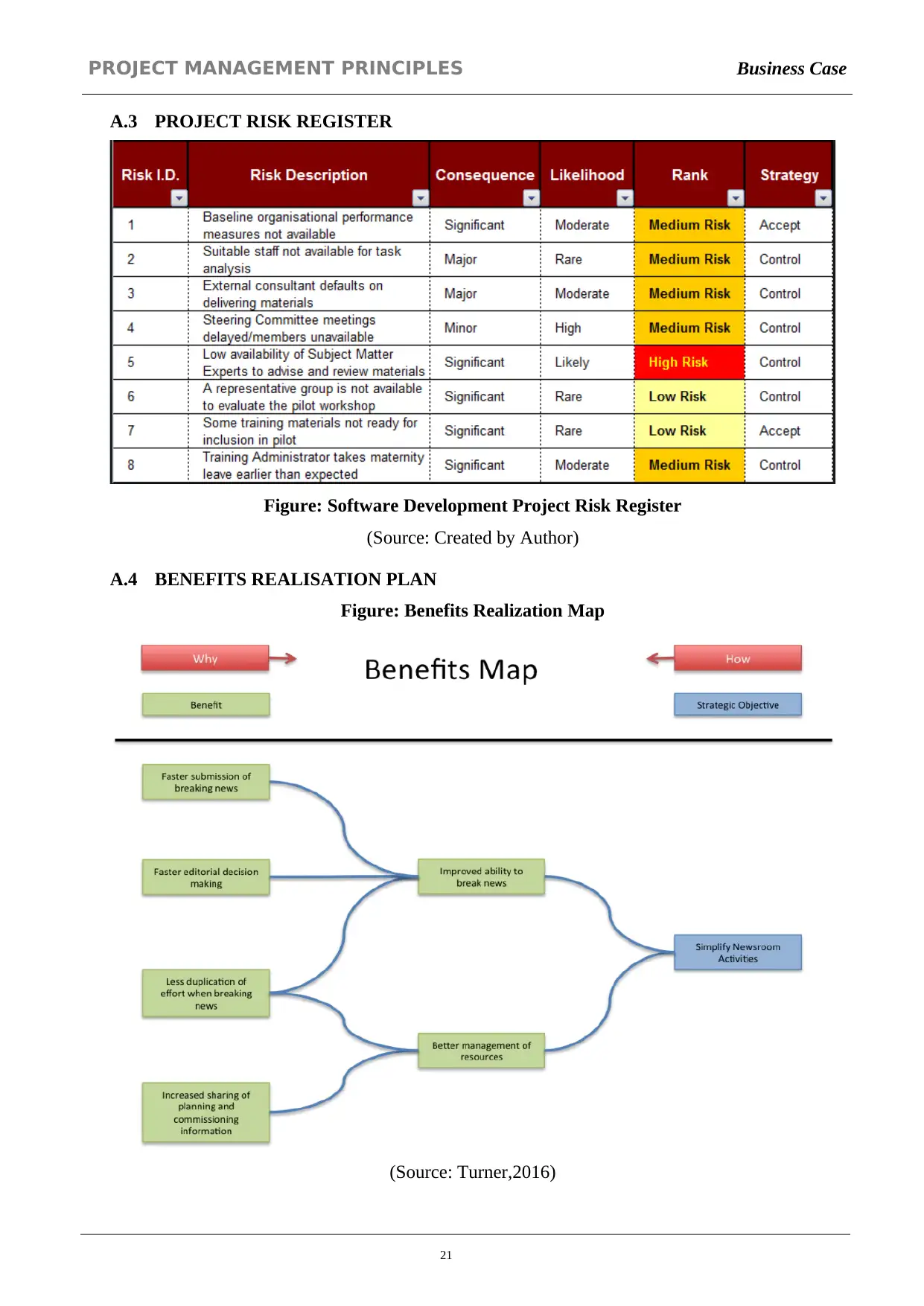
PROJECT MANAGEMENT PRINCIPLES Business Case
A.3 PROJECT RISK REGISTER
Figure: Software Development Project Risk Register
(Source: Created by Author)
A.4 BENEFITS REALISATION PLAN
Figure: Benefits Realization Map
(Source: Turner,2016)
21
A.3 PROJECT RISK REGISTER
Figure: Software Development Project Risk Register
(Source: Created by Author)
A.4 BENEFITS REALISATION PLAN
Figure: Benefits Realization Map
(Source: Turner,2016)
21
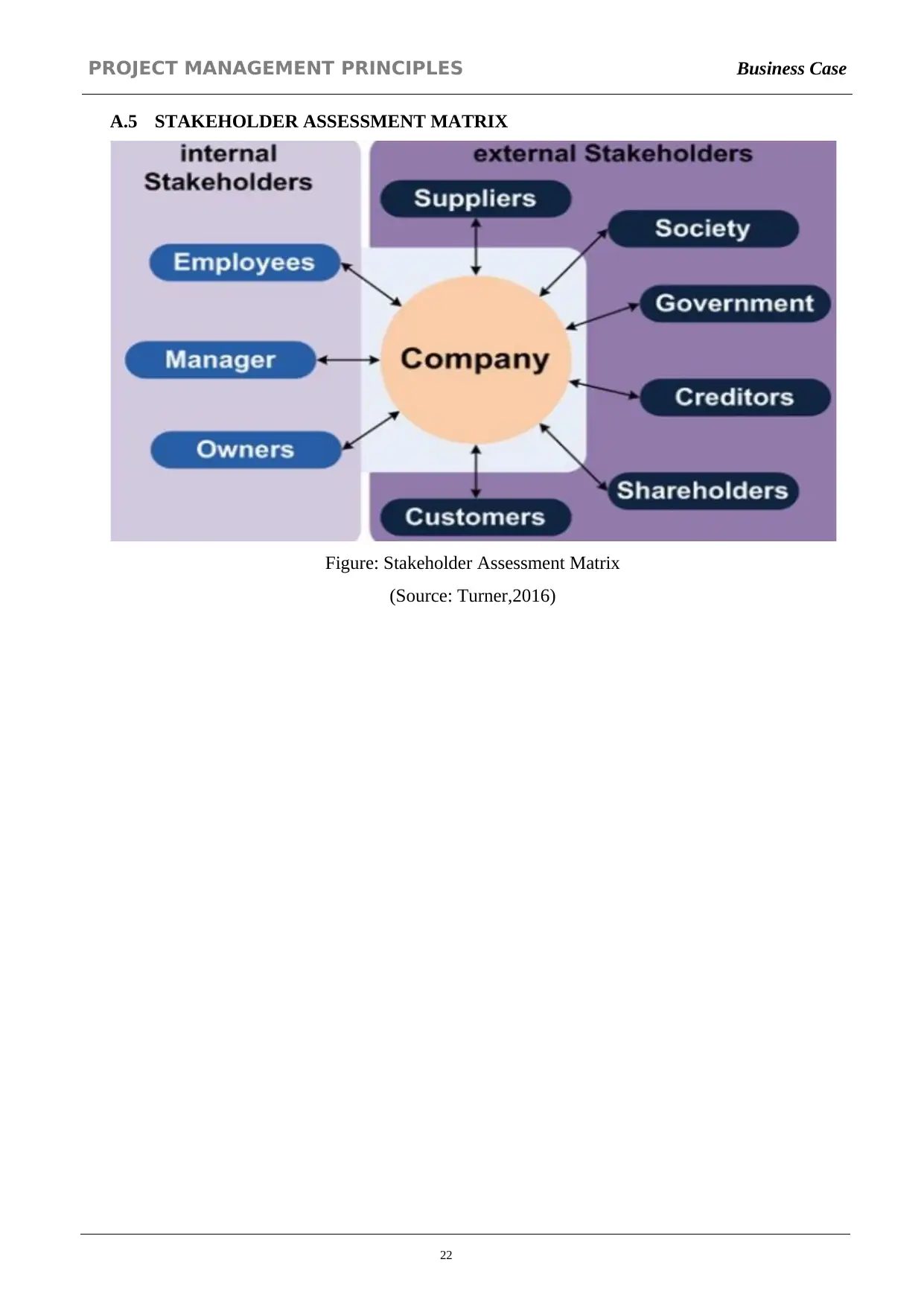
PROJECT MANAGEMENT PRINCIPLES Business Case
A.5 STAKEHOLDER ASSESSMENT MATRIX
Figure: Stakeholder Assessment Matrix
(Source: Turner,2016)
22
A.5 STAKEHOLDER ASSESSMENT MATRIX
Figure: Stakeholder Assessment Matrix
(Source: Turner,2016)
22
Secure Best Marks with AI Grader
Need help grading? Try our AI Grader for instant feedback on your assignments.

CITY OF GOLD COAST. Business Case

Business Case
1 out of 24
Related Documents
Your All-in-One AI-Powered Toolkit for Academic Success.
+13062052269
info@desklib.com
Available 24*7 on WhatsApp / Email
![[object Object]](/_next/static/media/star-bottom.7253800d.svg)
Unlock your academic potential
© 2024 | Zucol Services PVT LTD | All rights reserved.





